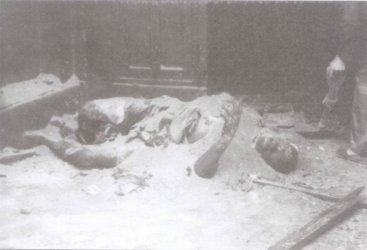
Victim of the "cow" explosion
Warsaw Insurgents Cemetery in Wola
Adolf Hitler fell into rage when was told that an uprising broke out in Warsaw and the Polish underground took up arms against Germans. Hitler ordered to raze the city and murder all the Warsaw inhabitants no matter of sex and age. And the German troops started following the order immediately. The city was sealed off the ring of death. The German troops had an enormous advantage in military equipment comparing to what was in possession of the insurgents and from the very first days, started to flood the city with a hail of bullets.
On the front lines, insurgents died from bullets, tank shells and mortar bombs. Freely flying German dive-bombers Stuka dropped bombs on Warsaw districts surrounded by the enemy. Artillery shells blew up in the streets.
In Old Town and Downtown, the Germans fired rockets called by the Varsovians "cows" or "wardrobes" because of the specific sound they were making while they were fired. It was a terrible weapon. A set of six rockets had 4 demolition rockets and 2 napalm rockets. The buildings hit by the "cows" collapsed like a house of cards and people inside or in the near distance from the building burned like human torches.
Germans also used the heaviest available at the time military equipment. They even brought a siege mortar Karl-Gerät, which was used in attacking the Soviet fortresses of Sevastopol. The 550 mm mortar shells had a length of 2 meters and the weight of 2 200 kg. Paradoxically, this weapon did not work out in Warsaw as it was too powerful. Its shells were meant for destroying several metres thick concrete structures as fortress and its detonator was made for this particular purpose. Many shells fell on buildings, and through roofs and structural ceilings went down to the ground floor or basement and did not explode. Resistance fighters used the explosive compound, retrieved from unexploded shells to manufacture grenades. Several dozen years after the war, during the construction of Warsaw metro in the Świętokrzyska Street area, there were found two of those mortar shells. They were secured and defused by sappers.
The German forces committed unspeakable crimes and atrocities in the conquered Warsaw districts. When Wola district was conquered, Wola was the first target in the German plan of defeating the Insurgents and was attacked first, within only few days Germans murdered thousands of people, mainly civilians. The total number of victims of the Wola massacre is unknown. It is said about 50 000-80 000 murdered. The German troops shot dead men, women and children. Murdered pregnant women, the ill and wounded in hospitals, priests and insurgents taken prisoners.
The bodies of the dead were thrown into holes or burned on piles of the corpses. In order to dispose of the bodies, Germans formed a special unit called Verbrennugskommando Warschau which consisted of Polish hostages sentenced for extermination. Only in one place of mass execution at 51 Górczewska Street, next to the railay viaduct, within several days, between 5th and 12th of August 1944, German troops shot dead and burned 12 000 Varsovians.
Those who miraculously survived the massacre were gathered at St. Wojciech church in Wolska Street where Germans designated a gathering point. After initial selection, part of the gathered people were shot dead and the survivors were sent a transit camp Durchganslager 121 in Pruszków. There was another selection at the camp, and next stop was either death camp or forced labor in the Third Reich, in few cases Varsovians were sent to General Government, still in German hands at the time. Other conquered districts suffered the same fate as Wola. The same situation repeated in other districts conquered by Germans: Ochota, Stare Miasto, Powiśle, Czerniaków, Mokotów and Żoliborz. Thousands of residents of Downtown-South were murdered and burned in the ruins of the pre-war GISZ building (Main Inspectorate of the Armed Forces), the Henryk Jordan garden, located in Ujazdowskie Avenue at Bagatela Street.
Daily death toll in the fighting districts varied from over a dozen to several hundreds dead, in the majority civilians. Those losses could have been much lower if the insurgents had military equipment to fight the German Stuka bombers which reigned in the sky over Warsaw throughout the Uprising. Unfortunately, the Warsaw insurgents had no anti-aircraft artillery. If the Russian fighter aircrafts had engaged and fought the Stukas, German supremacy in the sky over Warsaw would have ceased. From military point of view, such engagement was possible. The Russians had advantage in the air as they had more aircrafts than the Germans and their landing fields were situated just few dozen kilometres from Warsaw. They could have bombarded the German landing fields from which every single day the Stukas took off to bombard Warsaw.
Provisional cemeteries (photography: F. Dobrzyński, H. Śmigacz)
Warsaw, February 1945; left: Old Town market, right: Mostowa Street (photo: Sempoliński)
The Grave of an Unknown Resident of Warsaw
In the liberated city, at once started appearing those who managed to survive the Uprising and avoided the displacement. At first, the only way into the left bank Warsaw was from the east, through frozen solid Vistula river, as all bridges were blown up by the retreating German forces. January was biting cold. The river was frozen solid and trucks could easily go through it to the city. Later on, a temporary pontoon bridge was thrown across the river by sappers.
It needs to be noted that in spite of best efforts of the Red Cross searching teams, only small percentage of the deceased was identified. The activities started in spring 1945 so it happened several months after the Uprising. Passage of time, warfare and in many cases, barbaric behaviour of certain people, made a great deal of the deceased unidentifiable. Even if there was a cross on the grave during the Uprising, it did not mean that afterwards, when the registration and exhumation works started, the cross was still there.
Colonel Jan Mazurkiewicz "Radosław", commander of the "Radosław" Group, who dealt with organising plots for the fallen insurgents at Powązki Military Cemetery, approached two architects, prof. Romuald Gutt i Alina Scholtz, and ask them to create a design of insurgents cemetery.
The solemn consecration and the necropolis opening took place on 29.11.1945 at 11 a.m. Initially, the necropolis was called Cemetery of the Fallen during the Uprising and renamed in the middle of the 50's to Warsaw Insurgents Cemetery. First burials of the deceased collected from all Warsaw districts took place yet in November. At first, there were buried corpses of those who were never buried and found in the ruins and flats across Warsaw.
At the same time, there were discussions about the status and the size of the cemetery and whether or not it was to become a war cemetery. The main landscape attraction of the cemetery meant to be a monumental alley with rows of memorials, leading to a square where celebrations and drumhead services would take place. The cemetery area was to occupy space of 13 hectares.
The Polish Home Army soldiers came back to Warsaw from the post-Uprising wandering and POW camps. Members of the "Kedyw" {The Special Operations Executive of the Polish Home Army - J.K.} and newly founded "NIE" organisation {a military cadre organization which took over tasks of the disbanded Polish Home Army and continued the fight for independence against the Soviet Russia. Its name can be translated in two ways: either "No" (Polish 'Nie') as the first three letter of a Polish word for idependence (NIEpodległość) or as a symbol of resistance against the Soviet Russia - J.K.} engaged in searching and identifying the deceased soldiers, marking the bodies, witihin activities run by the Polish Red Cross, and burying the fallen, if possible. Those works were coordinated by Colonel Jan Mazurkiewicz "Radosław".
Facing the increasing aversion of the Lublin government and communist authorities in Warsaw towards the Polish Home Army, its fallen soldiers were buried at the Warsaw Insurgents Cemetery as unknown civilians. Warsaw Uprising and its role in the history of Poland began to be gradually diminished and the number of its participants marginalized at all costs.
The biggest and the most shocking funeral took place on 6th of August, 1946. The funeral procession went through the city carrying the ashes and remains of people murdered and burned by the Germans during Uprising in Wola, Pawiak area (Gestapo headquarters in Szuch Avenue), and ruins of the pre-WWII General Inspector of the Armed Forces building in Ujazdowskie Avenue.
Documents containing a list of the found human ashes
The open box army trucks carried 117 big coffins guarded by the Polish Red Cross sisters. The trucks passed slowly along the lines of Varsovians standing on the pavements and paying tribute to the martyrs. Among the murdered were also insurgents taken prisoners by the German troops.
According to the information dated August 1946, there were around 10 000 exhumed bodies buried at the Warsaw Insurgents Cemetery in Wola, excluding ashes buried in a special crypt. It was planned to fence the cemetery with a stone wall.
The second phase of exhumation commenced in spring 1947. Mass graves were open, into which, in 1945, the bodies of the fallen were temporarily transferred in various districts of Warsaw. Established at the end of 1945, the Union of Participants of Armed Struggle for Independence and Democracy took over all matters related to the fallen Warsaw Insurgents.
It was not a random process. All those anomalies observed during all the stages of the exhumation was not accidental. Polish government at the time, diminished the ethos of the Warsaw Uprising and mass participation of the Polish Home Army soldiers in the Uprising. And so, the management of the Powązki Military Cemetery in Wola was against further burials of the Polish Home Army soldiers at that cemetery and decided to bury them at the cemetery in Wola. The bodies laid there unattended and without coffins. Exhumed and unburied bodies were stored at the Powązki chapel from the autumn 1946.
In the mass grave at the Krasinscy Garden, apart from others, were also human remains of the deceased People's Army soldiers fighting in Old Town. At the time, there were observed anomalous occurrences of stealing bodies or changing their unit qualifications. Those practices were made in order to expand the People's Army's section at the Powązki Military Cemetery despite the commonly known fact that this formation was rather small and did not play a big role in the Uprising.
At the cemetery are laid to rest from 8 000 to 10 000 insurgents. The rest of the buried are civilian victims. According to the cemetery register, there are 104 105 deceased buried there, mainly fallen during the Uprising. 80% of that figure are civilian victims. And this is around 70% of the fallen and murdered during the Uprising. This is the biggest war cemetery in Poland and one of the biggest in Europe. The exact number of the deceased was probably made by adding up an approximate number of the ashes buried under the barrow to the exact number of bodies exhumed from the mass graves. So far, only 3 300 names has been identified. The rest is unknown.
At the beginning of the 60's, the cemetery went through "renovation" works. The Gutt and Scholtz design was definitively dropped. The official reason fo dropping the assumptions of the project was the lack of funds. The design of the artist Tadeusz Wyrzykowski was implemented.
The insurgent character of the cemetery was blurred. Next to the insurgents were buried soldiers of the Polish Army killed during the September Campaign 1939, victims of the German occupation 1939-1945, Jews executed by the Germans at the Skra stadium between 1940-1943, soldiers of the People's Army of Poland, the Red Army soldiers killed on Polish soil in 1945, resistance fighters, and even after-the-WWII-militia members enforcing People's Poland.
This operation allowed to put inscription on the plaques: "At this cemetery are laid to rest the bones and the ashes of the heroic people of Warsaw, members of the resistance and soldiers fighting for liberation of the capital from German occupation between 1939 and 1945". There was no word about the Uprising or Polish Home Army. It was a conscious act of falsifying the Polish history.
The remaining 6,5 hectares of the ground was converted to a park with no particular name and planted oak trees. Later on the park became the Warsaw Insurgents Park.
The place became lifeless, sterile and bland. In order to add any new name to the existing tombstones it was required to have special permission from the Society of Fighters for Freedom and Democracy and the society was very reluctant to give such a permission. For years, it was disallowed to put any plaque or plant flowers. Instead, the announcement plaques turned up at the cemetery which read: "It is not allowed to place any inscriptions on tombstones or graves and change the vegetation arrangement at the cemetery". In order to make sure visitors and relatives of the buried act in accordance with the directive, there was set up a Citizens' Militia station based at the cemetery and situated at the only survived cemetery building at the Wola cemetery entry. Every now and then the cemetery was visited by members of the communist secret police. The biggest Warsaw Insurgents necropolis became a forgotten place.
Most of the visitors is not aware that this is a huge grave of 50 000 murdered and burned Varsovians. A small plaque, especially placed at the back does not correct their perception.
There are more examples than the above presented. On a very small area of the cemetery, there are buried over 104 000 people who fell during the Uprising. The biggest Polish necropolis deserves to be taken out from the shadows of forgetfulness.
Not everybody among those who survived the Uprising agreed with the practises of the communist State and ZBOWiD (Society of Fighters for Freedom and Democracy). One of those was Mrs Wanda Traczyk-Stawska ps. "Pączek", a Private and a Liaison Officer of the Protective Security Unit (Secret Military Publishing Works). Her unit was very well-armed and that's why the unit was often supporting other units fighting in Downtown-North area. Her comrades were buried in provisional graves located situated in the area they fought and fell, Marszałkowska Street, Królewska Street, Nowy Świat Street and Jerozolimskie Avenue. After the Uprising capitulation in October 1944, Wanda Traczyk-Stawska marched out with her unit to POW camp. She came back to the country in 1947.
In 1947, at the St. Cross church at Nowy Świat Street took place a holy mass for the fallen unit members in which participated the survivors of the unit. After the mass, the last commanding officer of the unit, Lieutenant Stefan Berent ps. "Steb" gave an order to Master Corporal Wanda Traczyk-Stawska ps. "Pączek" and Master Corporal Cadet Andrzej Korycki ps. "Sokół" to find all burial places of their fellow unit members and make sure they are remembered and rest in peace.
Throughout all that time, with help of a group of friends, she was trying to spot the burial places of her fallen comrades. First in hiding and openly since 1989, they collected names of the fallen soldiers and civilians buried anonymously at the Warsaw Insurgents Cemetery. In the 80's, Wanda Traczyk-Stawska started cooperation with the 145 Scout Team from Międzylesie. They helped with collecting names and keeping the cemetery tidy. In 1984, after the "Sokół"'s death, Wanda Traczyk-Stawska began a cooperation with Krystyna Zbyszewska ps. "Zbyszek", fellow girl scout known from Oberlangen camp and the School of Younger Volunteers in Palestine. When the Uprising started, Krystyna Zbyszewska was 14 years old and served in the Scouting Field Post Office and the 1st "Bradl" squad. Her sister, also the Polish Home Army soldier, is buried at the Warsaw Insurgents Cemetery.
The press always very briefly informed about the Warsaw Insurgents Cemetery and its fate. "Stolica" in 1957 wrote a short article titled: "Graves almost forgotten". The article mentioned a funeral of human ashes in the summer 1946, condition of the cemetery after 11 years from that occurrence, and caved in graves and rotted crosses. The author foretold that if nothing changes at the cemetery, the insurgents' graves just disappear and the place becomes just an ordinary field.
Regretfully, the crosses were devastated by unknown perpetrators soon after they were put on the barricades. Someone poured the black paint on the crosses and detached their crossbars. Regretfully, the Police were unable to find and name the perpetrators. As a result, the crosses had to be disassembled. Additionally, the metal inscription was stolen. Phantoms of the past have not died yet.
,At the same, an inscription on the information plaque on the barrow was changed and the new inscription reads: "Here lie ashes of over 50 000 Poles, civilian residents of Warsaw and the Polish Home Army soldiers, who fell for the country and were murdered by the Germans during Warsaw Uprising in August and September of 1944. On 6th of August, 1946, 117 coffins were placed here with the ashes of victims murdered and burned, brought here, among other places, from Gestapo Headquarters in Szucha Avenue, Wolska Street, Górczewska Street, Sowiński Park, St. Stanisław hospital (Franaszek factory), Moczydło Street and Młynarska Street".
In 2004, at the 60th Warsaw Uprising anniversary, few things happened. A block of stone was positioned at the cemetery from Wolska Street informing about the cemetery stretching behind the stone.
And from Sowiński Street, there was placed a new information plaque notifying about the place laying behind it. The plaque reads:
Unfortunately, the cemetery is still not fenced and easily accessible for visitors. To raise visitors' awareness, a plaque with similar inscription should be placed at the Wolska Street entry.
In the autumn 2004 on the square at the junction of Leszno Street and Solidarność Avenue, there was unveiled a monument in tribute to 50 000 inhabitants of Wola district murdered by the Germans during the Warsaw Uprising in 1944. The monument carries inscriptions listing all the mass murder sites where the German soldiers murdered the Wola district residents in the first days of August, 1944.
On 15th of July 2010, Warsaw City Council decided that the 5th of August will be celebrated as the all-Warsaw Day of Remembrance of the Wola district residents murdered by the Germans during Warsaw Uprising.
The Warsaw Insurgents Cemetery
The Warsaw Insurgents Park
Information plaques between the cemetery and the park
April 2014 *
The 71st Warsaw Uprising Anniversary is coming soon. Within more than ten months which passed from the moment this material was written, we may observe many positive changes at the Warsaw Insurgents Cemetery.
Two columns erected by the Wolska Street entry. The columns appear to be some sort of cemetery gates to the cemetery which is still unfenced.
Most of the walkway surfaces were replaced.
The Wola district City Hall carried out a makeover of the scarp and two alleys, one leading towards the cemetery from the Sowiński Park and the other one, from Wolska Street. Also the road leading to the cemetery and the parking zone were refit. The greenery between the square in front of the barrow and the pond located towards Wolska Street.
Eagles carved on the columns, one of them symbolizes the national emblem and the other one the Polish Armed Forces emblem, the coat of arms of Warsaw and the 'Poland Fighting' symbol along with a sentence in Polish and Latin: "They died so we can live free"; "Mortui sunt ut liberi vivamus".
On the column, there are also two verses of the poem by the Warsaw poet Artur Oppman.
Oh, city of mine, oh, holy Warsaw!
On this grave, when you are laying a flower,
(photography P. Śmiłowicz)
In front of the barrow, which in fact, is a mass grave, there is a barricade on which there is an additional memorial plaque.
The wording on the plaque reads: "This is a mass grave in which are buried the ashes of over 50 000 inhabitants of Warsaw and insurgents killed and murdered during the Warsaw Uprising". The additional information should make people realise that the monument situated on the barrow is a place of remembrance which contains remains of over 50 000 inhabitants of Warsaw. At the moment, some people seem to not realise that and therefore, it appears necessary to separate somehow the barrow from the rest of the area. It could be a hedgerow, or a small granite frame in order to make all visitors fully aware that the place is one mass grave.
(photography W. Grzędziński KPRP)
Mrs Wanda Traczyk-Stawska ps. "Pączek" was seated next to the President. Thanks to her and other members of the Social Committee of the Warsaw Insurgents cemetery in Wola, the necropolis came out of the shadows of forgetfulness.
(photography W. Grzędziński KPRP)
The celebration drew a crowd of the Varsovians.
(photography W. Grzędziński KPRP)
A very symbolic and touching moment when Mrs Wanda Traczyk-Stawska reported to the President of Poland. Mrs Wanda Traczyk-Stawska reported that she carried out her uprising commander's order to find places where her brothers in arms where buried and make sure they rest in peace and are remembered. Her mission is complete after several dozen of years.
Section 81 - the fallen brothers in arms of Mrs Wanda Traczyk-Stawska from Protective Security Unit (Secret Military Publishing Works)
(photography W. Grzędziński KPRP)
Traditionally, the Warsaw Uprising anniversary was commemorated by the Legia Warsaw Fans.
(photography W. Grzędziński KPRP)
In the evening, a drumhead service took place by the stone altar with the cross and the Poland Fighting emblem.
(photography W. Grzędziński KPRP)
A book "Historia zapomnianego cmentarza" (History of the forgotten cemetery) was offered and sold to the guests participating in the celebration.
The works were scheduled to be finished by the end of 2014, and practically, the deadline was met. All the tombstones in the area behind the barrow were replaced. The tombstones were decorated with the cross, the anchor, 'Poland Fighting' symbol, and an inscription: Warsaw Uprising 1944. Although, not every tombstone of the victims buried in the mass graves has names on it, the full completion is expected in the near future, hopefully before the 71st anniversary of Warsaw Uprising.
(photography rigth P. Śmiłowicz)
The total cost of renovation works was around 5 200 000.00 złotych. The amount includes funds from the voivode budget, Council for the Protection of Struggle and Martyrdom Sites, Wola district and Roads and Transportation Office.
As previously informed, on 14th of November 2014 there was announced a contest for architects to design a pavilion which will become the Memorial Chamber and the Memorial Wall at the Warsaw Insurgents Cemetery in Wola. The Local Development Plan will be changed and those changes will allow to alter the site and locate the pavilion in accordance with the winning design. The registration deadline was 12.12.2104 and the submission deadline was 24.04.2015.
(photography P. Śmiłowicz)
Authors of the winning work, in contrast to the majority of other works, do not propose to embed the pavilion into the ground. Apart from that, the project proposes to locate the pavilion in certain distance from the graves and the barrow containing human ashes. The proposed location of the Memorial Chamber is the east side of the cemetery, in the park area, and respectfully refers to the basic assumptions of the band's composition by Romuald Gutt and Alina Scholtz.
Building of the pavilion requires to change the local development plan as at the moment it does not allow to carry out such projects in the cemetery area. Works in terms of the required changes has already started. In the meantime, it is time to prepare a detailed schedule of works. When the local development plan is changed, the pavilion works may begin. Once the pavilion and the memorial wall are built, it is time to properly commemorate the buried at the cemetery, so the name "forgotten cemetery" will no longer be a synonym of the cemetery. July 2015 *
At until-recently-forgotten Warsaw Insurgents Cemetery something is going on all the time.
Over 90 tall glass prisms were erected in the park. The prisms show over 50 000 names. Every name has allocated a date of birth and a name of the place that one was seen last.
A poem by Tadeusz Gajcy titled "Sing of the walls" is inscribed on the prism by the exhibition entry to welcome the guests:
At night, when the city will sail away in the third slumber,
When it gets dark, the prisms are illuminated to intensify the emotional context of the exhibition. This is the biggest collection of individuals who died during the Warsaw Uprising.
Concept: Jan Ołdakowski, Dariusz Gawin, Paweł Kowal
Thanks to the information received from the public so far, the list of victims was updated and 1 754 new names were added, apart from that the existing 3 316 records were corrected.
Currently, there are 57 189 names of the victims places on the prisms.
The March of Remembrance is organised since 5th of August, 2015. After the official celebrations in tribute to the civilians of Wola district that takes place by the Monument of Remembrance located at the junction of Leszno Street and Solidarity Alley and erected in memory of 50 000 of Wola inhabitants murdered by the Germans during the Uprising, the Varsovians walk through Okopowa Street, Wolska Street and Redutowa Street to the Warsaw Insurgents Cemetery in Wola.
Along the way, participants of the march, the Warsaw Uprising Museum volunteers and Varsovians lay flowers and light candles, they stop at over 20 spots which commemorate executions committed on Polish citizens in 1944. March of Remembrance, as well as the official celebration at the Warsaw Insurgents Cemetery in Wola, has become a traditional way of the August celebration in Wola.
Wanda Traczyk-Stawska explains the idea of commemoration:
- Let there be no more war;
In the celebration of unveiling the monument participated Wanda Traczyk-Stawska and other representatives of the Social Committee for the Warsaw Insurgents Cemetery, combatants, students from Wola schools, scouts and Varsovians.
The tradition of granting the honorary citizenship goes back to 1918. The City Council gave the title in the years 1918-1929 to people who were especially distinguished for the capital. The tradition was reinstated in 1992. The award of the title is the expression of the highest distinction ad recognition for the merits and/or exceptional achievements of Polish citizens and foreigners.
Apart from Wanda Traczyk-Stawska, two other individuals became honorary citizens of Warsaw: Wiesław Johann, a judge of the Constitutional Tribunal in retirement and an actor Daniel Olbrychski.
Thanking for the title, Wanda Traczyk-Stawska said this award is an honour not only for her, but also for all of those who helped the Warsaw Insurgents Cemetery to come out of the shadows. She thanked many people and institutions. She also reminded that there is still work to be done at the cemetery, namely Memorial Wall and Memorial Chamber. She said that without the Chamber, those who are laid to rest there are only an unknown heap. She appealed for help in collecting souvenirs commemorating the deceased buried at the cemetery.
There are also activities related to the implementation of Memorial Chamber in the Warsaw Insurgents Park. Works on the local area development plan are in the last stage which may mean that building of the Chamber may start in the near future.
On the cemetery wall, behind the stone altar, where holy masses are offered annually at the Warsaw Uprising anniversaries, a poem "The Grey Rehiments' Prayer" has appeared recently. It was written in June 1942 by Jan Romocki a.k.a. "Bonawentura", the younger brother of Andrzej Romocki a.k.a. "Morro".
photographs taken by: Agnieszka Pawelec
photographs taken by: Agnieszka Pawelec
photographs taken by: Agnieszka Pawelec
photographs taken by: Agnieszka Pawelec October 2017 *
In the year 2018 r. the City of Warsaw changed its plan of managing the Park of the Warsaw Insurgents, that adjoins the Cemetery of the Warsaw Insurgents, especially with the thought of the Memory Hall. Previous decisions did not allow any facilities to be built there.
At the end of July 2019, during his meeting with the Insurgents, President of Warsaw Rafał Trzaskowski signed an agreement to build the Memory Hall.
In the year 2020 the Warsaw Management of the City Expansion, as a supervisor of the erection, twice invited tenders to for a piece of work. In both allocations by tenders the cheapest offer was gives by CO consortium MTM Budownictwo from Tarnów and PBO Śląsk from Sosnowiec. Unfortunately, in both cases the bid amount of money hugely exceeded the assumed investment budget of 15,1 million of PLN.
As the Warsaw city hall informed, the building of the Memory Hall is going to be comprised of blocks fulfilling particular functions, limited by two massive walls. In the entry space, from Wolska street side, there will be a block meant to be an educational room for future lectures, student workshops as well as film and archive materials displays.
visualization of the Memory Hall (Piotr Bujnowski)
On August 1, 2020 at 2 p.m. the ceremony of sinking into the ground the charter of foundation of the future Memory Hall, in which the following people participated:
During the ceremony these people took the floor consecutively: Wanda Traczyk-Stawska, Konstanty Radziwiłł, Rafał Trzaskowski and Ewa Malinowska-Grupińska.
Konstanty Radziwiłł said, among the others,
August 1, 2020
The President of Warsaw Rafał Trzaskowski put an emphasis that,
We look forward to the beginning of the building operations of the Memory Hall by the Cemetery of the Warsaw Insurgents. We do hope that the coronavirus pandemic will not delay the finish of the construction that is expected for July 2022. November 2020 *
In accordance with the schedule, the building area was formally transferred to the contractor on October 22, 2020.
During the period November 18 - December 10, 2020 probationary works were being continued in the area, i.e. planting and cleaning of the ground.
Next, from December 11, 2020 essential works devoted to power grid were being executed.
In addition, two gateways were inserted into the enclosure, both from the direction of Sowiński street. Thanks to that, heavy building equipment could get into the area with appropriate constructional steel. A crane was installed, as well.
Thereafter, a 1,5-metre-deep trench needed for the Hall foundations started to be made. Workers had to face an unexpected obstacle. It turned out that underneath there was unstable foundation full of waste and glass which had to be gathered there for many years, in a pre-war period or even before.
Then, reinforcement works leading to laying the foundations began. They lasted till the middle of April 2021.
On April 23, 2021 the lower foundation slab of the building was placed. After vital time of conserving the construction, the next stage of the works followed.
In the second half of May 2021 builders started preparing reinforcement of side walls and then coving them with concrete. .
Technology used here means covering side walls with concrete plates which are 0,5 meters thick each. Nine layers were spilled. Appropriate time had to go by between subsequent actions. Each layer needed to be adequately consolidated. The concrete layers were finally spilled in June 2021.
Afterwards, the actions of timbering the ceiling, reinforcing and laying concrete were finished. Closing the building is predicted to happen in October 2021. Interior works are going to begin at that time. *
On July 29, 2021 at 10:30 a.m. in the Warsaw Insurgents park by the Warsaw Insurgents Cemetery in the Wola district began the solemnity of laying the foundation stone for the Memory Hall premises.
Let me remind you that on August 1, 2020 nearby the place of the above-mentioned ceremony a little oak called a Memory Tree was planted exactly on the place of the future Memory Hall. In the oak's roots the charter of foundation of the Memory Hall was put. Its title reads, "To live in one's family town...". You can read the content of this document thanks to the report of the Memory Tree planting.
A part of the enclosure of the building site had been temporarily laid open in order to allow the gathered people see the progress of works in the Memory Hall.
Approx. 10:00 a.m. the guests took their seats.
When the guests had been greeted by the chairman, the municipal policeman played the Warsaw Bugle-call.
During the ceremony these people took the floor consecutively: Mrs. Wanda Traczyk-Stawska, Mr. Rafał Trzaskowski and Mrs. Ewa Malinowska-Grupińska.
She said, among the others,
He said, among the others,
She said, among the others:
The following piece of information was put inside the tuba,
A year after the solemnity of painting the Memory Tree into the roots of which the Warsaw Insurgents' Cemetery Memory Hall's charter of foundation had been placed, today we are building in the corner-stone.
"Doctor Major Włodzimierz Aleksander Kmicikiewicz a.k.a. "Lech", or "Nitecki Jan" was a surgeon.
It was the last stage of the solemnity. The concrete brick is going to be put in a suitable place inside the Memory Hall foundation. August 2021 *
Despite unfriendly circumstances (the Covid-19 pandemic) the works on the Memory Hall construction were not getting slower.
photographs taken by: Agnieszka Pawelec
Unfortunately, Stalin purposely did not want to support and help the Insurgency, in spite of the fact that just few days before the Uprising started Radio Moscow broadcasted in Polish an appeal to Varsovians and urged them to rise up against the German occupiers. Stalin did not want to see Polish Insurgents win in Warsaw as it collided with his plans to enslave Poland, which plans, shamefully, were agreed with and approved by the governments of United Kingdom and United States of America. In the name of their own benefits and in exchange for Russians' involvement in war, the governments of United Kingdom and United States of America abandoned, some may say betrayed, the Polish ally and let Stalin incorporate Poland to the postwar Soviet empire.
The Russian Red Army, in their march west, approached the Vistula river yet in July 1944, however after the defeat in a tank battle the same month, they slowed down their offensive actions towards Warsaw. The Soviet Army held back until mid-September when after a few-day-battle conquered the right bank Warsaw, Praga and Grochów. And then stopped their offensive actions again and watched the left bank Warsaw and the Insurgents bleed. The Red Army's inaction was and still is viewed as a deep betrayal.
The overall situation in Warsaw was not changed by landing operation undertook between 16th and 19th of September, 1944 by very small forces of the Soviet's Polish First Army commanded by General Zygmunt Berling. Soldiers of the Soviet's Polish First Army carried out a landing operation without aircraft or artillery support and as a result, the landing was ineffective and ended up a massacre. The majority of soldiers of the First Army participating in the landing operation got killed yet in pontoons on the river and those who reached the left bank got slaughtered by Germans in Czerniaków, Powiśle i Żoliborz.
The conditions in Warsaw districts under siege made impossible to bury the fallen insurgents and the dead of wounds civilians at cemeteries. The only way to bury them at all was to bury them anywhere where possible and where space allowed to do so. Provisional graveyards appeared on pavements, lawns, squares, backyards and hospital courtyards.
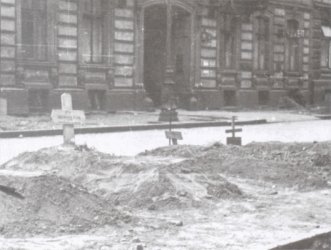
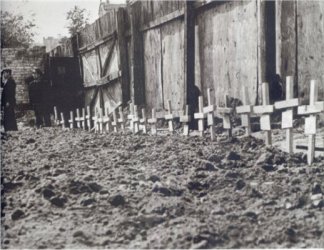
Rows and rows of crosses grew on the streets of Warsaw. At first, the dead were buried in coffins, but after a while the supply of coffins in the city ran out. So, the dead were buried in shallow graves with crosses on the top if possible. It was imperative to mark the deceased and leave sufficient information allowing identification of the dead once exhumation takes place. Names of the dead were inscribed on the crosses, a piece of paper left in the pocket of the clothing or uniform, and sometimes it was a piece of paper left in the bottle and placed next to the body in the grave.
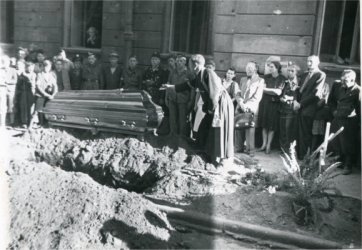
Funeral of a fallen insurgent (APW)
Soldiers of the regular army are equipped with so called dog tags which are used for identification of dead and wounded soldiers. For obvious reasons, insurgents were not equipped with those. The only identification document they had on them was either the Polish Home Army ID, Kennkarte, Ausweis or school ID.
Many resistance fighters did not manage to get to their gathering points on time. So they joint up with random units they met and fought Germans with their new units. Resistance fighters mainly did not know their fellow soldiers' names, but only their pseudonyms. When one got killed, in many cases, it was impossible to leave any other identification clue but the pseudonym only.
Sometimes it looked similarly in respect of the civilian victims when one died or got killed away from their homes and were unknown to those who witnessed their death or there was no witness at all. If they had no ID on them at the time they died or got killed and no one could verify their identity, then they were buried as unknown person.
From time to time, retreating insurgents had no choice or possibility but to leave their fallen comrades unattended. Many of those bodies stayed unburied or caved in by the rubbles. Many civilians also died under the buildings reduced to rubble.
After the capitulation of the Uprising on 2nd of October, 1944, the insurgency units, now prisoners of war, marched out of the city and were sent to POW camps. Civilian survivors were banished to a transit camp, Dulag 121, in Pruszków. The number of the Dulag 121 prisoners reached over 650 000 Varsovians. The capital became a silent cemetery.
During the next three months the Germans troops gradually robbed and destroyed the rest of the survived buildings. German sappers blew up the whole blocks, robbing beforehand everything that had any value. In that period of time, Warsaw was destroyed in a bigger degree than during the September Campaign 1939 and the 63 days of the Uprising.
When on the 17 of January 1945 the Soviet Red Army and the Soviet's Polish First Army marched into abandoned by the Germans left bank Warsaw, they were welcomed by an enormous and snowed in cemetery, and silent and burned out ruins.
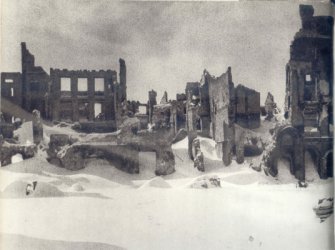
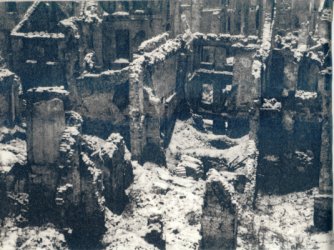
Rows and rows of crosses on provisional graves peaked through snow. Unburied bodies laid everywhere, in the streets and ruins, and the wind blew human ashes from the macabre piles of burned human remains.
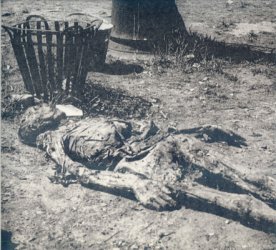
Krasińscy Square, May 1945 (photography L. Sempoliński)
A poet Antoni Słonimski, in October 1944 in London, wrote a moving poem which pays a tribute to the fate of Uprising Warsaw.
The antique, the naked and the huge,
Frozen into the shout of stone lips,
Which on arches of the triumphant arks
One day, the descendants will set up in rows,
Heroes of great days,
Against the background of flags and barricades,
The antique, the naked and the huge,
About whom everyday announcement
Gave the world a new rhapsody,
History will not forget about you
And the national bard will throw
A grain of martyrdom blood of yours
And the sow of suffering
And ecstasy
For the new August,
For the new September,
And the new sixty three days.
About you history will not forget,
But who will be sitting on the graves?
Those who horrified and homeless
Fell as the swarm innumerable,
Who will stand up for that million?
And what bard will be telling
Hot and crazy words
About those, who in the shadow of your glory,
Without a drug of great acts
Died in torments for the laurels,,
What did your temples decorate,
Throwing your rotten bodies
In the smoky, bloody filth of history?
For you this song of mine and the tears of mine,,
The ordinary, the simple, the not huge.
When life comes back to the rumbles,
On the national holy grave,
When the bones are collected from the earthwork,
To raise a monument of fame from them,
Let there be on the tombstone
This simple inscription, a bloody inscription:
Here lies the corpse
Of an Unknown inhabitant
Of Warsaw
Mogiła Nieznanego Mieszkańca Warszawy
Antyczni, nadzy i ogromni,
Zastygli w krzyk kamiennych warg,
Których na łukach tryumfalnych ark
Ustawią kiedyś w rząd potomni,
Bohaterowie wielkich dni,
Na tle chorągwi i barykad,
Antyczni, nadzy i ogromni,
O których co dzień komunikat
Podawał światu rapsod nowy,
O was historia nie zapomni
I narodowy rzuci pieśniarz
Ziarno męczeńskiej waszej krwi
I posiew cierpień
I uniesień
Na nowy Sierpień,
Nowy Wrzesień,
Na nowych dni sześćdziesiąt trzy.
O was historia nie zapomni,
Lecz któż na grobach będzie siadał
Tych, którzy trwożni i bezdomni
Padali mrowiem niezliczonym,
Któż się o milion ten upomni?
I jaki pieśniarz będzie składał
Słowa gorące i szalone
O tych, co w cieniu waszej glorii,
Bez narkotyku wielkich czynów
Konali w męce dla wawrzynów,
Co wasze skronie ozdobiły,
Rzucając pomiot ciał swych zgniłych
W dymiący, krwawy gnój historii?
Dla was pieśń moja i łzy moje,
Zwyczajni, prości, nieogromni.
Kiedy na zgliszcza wróci życie,
Na narodowy święty grób,
Gdy kości będą zbierać z szańca,
Aby z nich dźwignąć pomnik sławy,
Niech na cmentarnej będzie płycie
Ten napis prosty, napis krwawy:
Tu leży Trup
Nieznanego Mieszkańca
Warszawy
Early spring, the priority for the Warsaw authority at the time was to prevent the epidemic, which was likely to spread because of huge amount of unburied bodies within the city. The bodies of the fallen and murdered soldiers and residents of Warsaw laid in the streets, staircases, flats and basements and ruins of the destroyed buildings.
Municipal cemeteries had no sufficient space to bury such enormous amount of the deceased. Someone came up with a criminal idea to cremate all the bodies. The idea was highly immoral, and in fact resembled German practices carried out in Warsaw few months earlier. Apart from the moral aspect, in such case, any identification of the deceased would be impossible.
In that drastic situation, Mrs Jadwiga Boryta-Nowakowska, who dealt with cemeteries for Polish Red Cross, proposed to bury the deceased in provisional mass graves in several spots across the city, so appropriate services have sufficient time to prepare the needed number of graves, and later on, exhume the deceased and that way resolve the problem.
But beforehand, it was imperative to locate all graves from the Uprising and most of all, unburied bodies.
The Polish Red Cross Information Office started operating yet during the Uprising and collected data with regard to the fallen and wounded insurgents. The collected data was invaluable source of information for Polish Red Cross Search Office which even years after the war helped relatives and families in the search for missing people. Not every Warsaw district had such a list. The Old Town records were lost and the Wola records, for obvious reasons, never existed.
Inventory works, which stopped with the Uprising capitulation, restarted right after Warsaw was liberated. All left bank Warsaw, including suburbia, was divided into sectors. Each sector had allocated a two-member team, which searched buildings, gardens and other places. The teams started the search in February 1945 and continued into March. Brave Polish Red Cross sisters worked in a very difficult conditions. At the time, it was biting cold in Warsaw, subzero temperatures and blizzards. Apart from inclement weather, it was also still dangerous for the teams to carry out their duties, the teams consisted mainly of women, as big part of the city was not demined at that time.
Bearing in mind that finding bodies of the deceased was extremely important for their families and relatives, teams were trying hard to establish as much information as possible and collect any clues regarding graves and bodies identity. All data collected by the teams were gathered at the Polish Red Cross archives. Teams collected names inscribed on the crosses, ID's found on bodies, also spoke to people living in certain areas and could have any relevant information and already returned home.
In this way, a unique records regarding the fates of several thousands Warsaw inhabitants both, civilians and insurgents, were created. Thanks to those records and enormous job carried out by the devoted Polish Red Cross searching teams, it was possible to establish the exact place of death or burial places of many victims. In some cases, the records also allowed to correct inaccurate data. The original reports were published in Robert Bielecki's book "Żołnierze Powstania Warszawskiego" (Soldiers of the Warsaw uprising).
In accordance with the schedule, after the registration phase, another phase started in early spring 1945 and the deceased were buried in provisional mass graves. Those mass graves were located in the following places: Krasińscy Garden, Starynkiewicz Square, Wilson Square, Dreszer Park, Deaf-Mute Institute at the Three Crosses Square, junction of Czerniakowska Street and Okrąg Street.
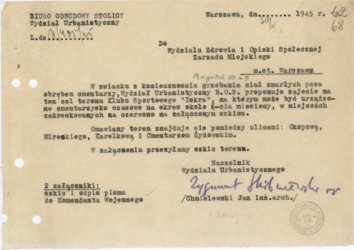
Letter regarding provisional cemetery at the Skra sport club in Wola (APW)
Many corpses, during the Uprising, were buried with ID's or deceased name put on a piece of paper, those were usually placed in the glass bottles. In certain cases, those bottles could not be found once bodies were exhumed for the first time. And those bodies which had them and were transferred to the provisional mass graves, at time of another exhumation, those bottles could not be found or somehow went missing. Some bodies were only tagged and those tags in certain cases were lost or went missing. As a result, only small percentage of the deceased was buried under their own name, the rest had to be buried as unknown victims.
An idea of creating a cemetery for the deceased in the Uprising was born already in July 1945. Its location was chosen by the Office for the Reconstruction of the Capital. The Office found an 8 hectare-field in Wola, next to the Catholic Cemetery in Wola, and approached the County Borough Warsaw West In September 1945 asking for their permission to locate there a cemetery. In their request they justified that the place is suitable location for the fallen insurgents as it is situated next to the Sowiński redoubt, the monument of two Polish uprisings, the November Uprising and the August Uprising.
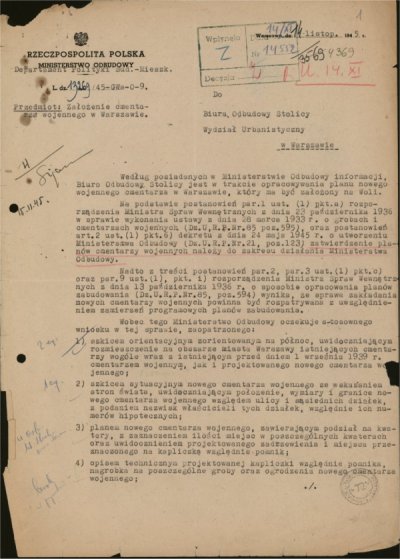
Letter dated 14.11.1945 describing details of the planned war cemetery in Wola district (APW)
The concept of a pair of excellent architects was to reshape the land between the Catholic Cemetery in Wola and Redutowa Street so it becomes a scenic cemetery and a park at the same time. One of the design assumption was that the main pathway is wide and leads to Redutowa Street, parallel to the southern wall of the Wola Cemetery.
In the middle of the pathway, they designed a barrow containing ashes of the murdered and burned Varsovians, on which supposed to be built a mausoleum in the shape of sarcophagus with a canopy supported by four columns and being a field altar at the same time. According to the design, rectangular cemetery sections were separated by rows of trees. Traditional tombstones were replaced with identical crosses, similar to those at Palmiry cemetery, which was also designed by Gutt and Scholtz. The necropolis meant to be picket fenced with climbers on it or hedgerow right next to it. Additionally, to make the area more picturesque, they planned a small pond at the cemetery.
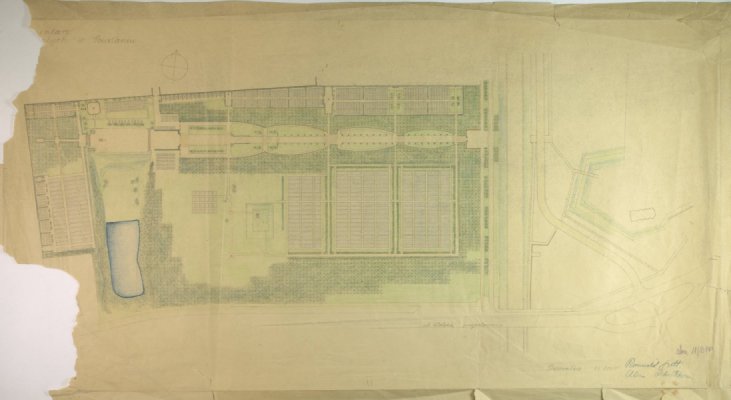
Design of the war cemetery in Wola prepared by Romuald Gutt i Alina Schlotz (APW)
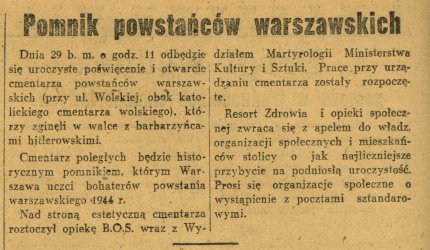
Newspaper article regarding the opening of the Warsaw Insurgents Cemetery in Wola (APW)
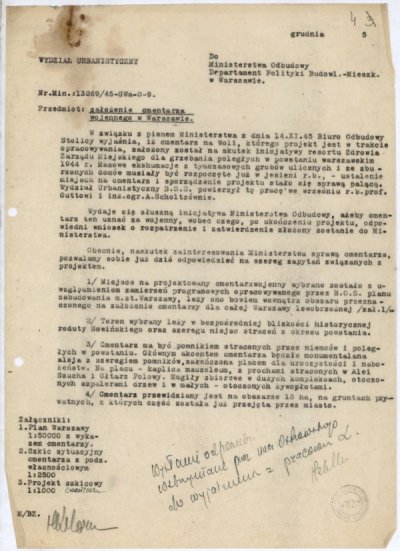
Letter dated 4.12.1945 regarding the details of the newly open war cemetery in Wola (APW)
The "Kedyw" soldiers from batallions "Zośka", "Miotła" and "Parasol" actively participated in searching and identifying corpses of the deceased Polish Home Army soldiers, before they were buried in collective mass graves at the following locations: Old Town, Krasińscy Garden, Czerniaków by the Vistula river bank. The Polish Red Cross team, cooperating with soldiers of the "Miotła" battalion, was led by Anna Pia-Mycielska (also a Polish Home Army soldier) who marked documents prepared by her with initials AM, the first document was dated 24.03.1945.
Despite the lack of people and means of transportation, as well as administrative difficulties they faced in spring and summer 1945, they managed to bury certain number of the insurgents at Powązki Military Cemetery. The burial places were arranged with M. Żemralski, the parish priest of St. Józef church. Exceptionally solemn was a funeral of Andrzej Romocki ps. "Morro" (a scoutmaster and a captain, the commander of "Rudy" Company of "Zośka" battalion) buried by his friends and fellow soldiers in the last decade of February 1945 at Powązki Military Cemetery.
At the turn of 1945/1946, in spite of serious problems caused by the communist authorities, the insurgents communities managed to secure 11 plots for the fallen insurgents, where the found and identified soldiers of particular groups and battalions were gradually buried.
After the opening of the cemetery in November 1945, the authorities decided to bury there all the Uprising deceased both, civilians and Polish Home Army soldiers. The number of the civilian victims in great deal exceeded the number of the fallen insurgents. Initially prepared graves quickly filled with corpses. Municipal Funeral Department approached the Office for the Reconstruction of the Capital in February 1946 and urgently requested to prepared more graves threatening to cease subsequent exhumations.
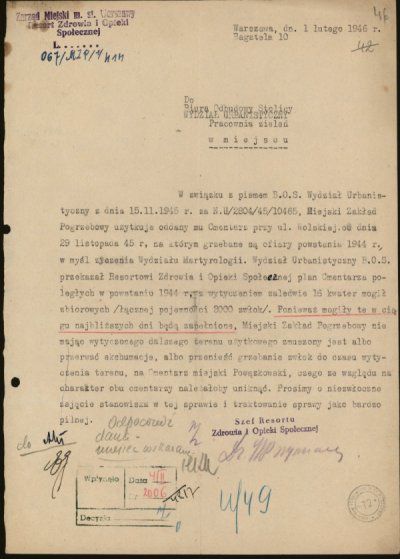
Letter dated 1.02.1946 regarding the lack of burial space at the cemetery at Wolska Street (APW)
The number of graves at the Wola cemetery systematically increased. In February 1945, a substantial amount of human ashes was found in the cellars of the pre-WWII General Inspector of the Armed Forces building in Ujazdowskie Avenue. With regard to that fact, it was decided to build a tomb at the cemetery in Wola, which has sufficient space, capacity of over a dozen cubic meteres, to accommodate the ashes.
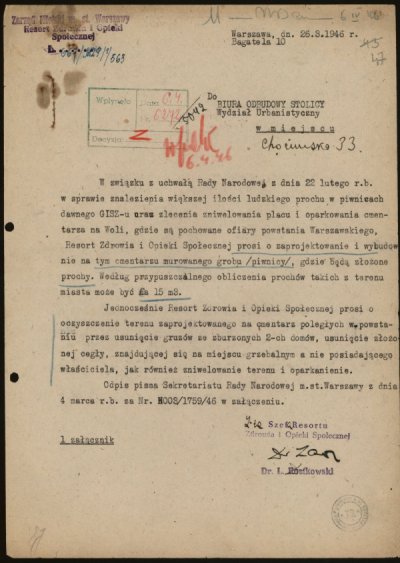
Letter dated 26.03.1946 regarding building of a grave for human ashes (APW)
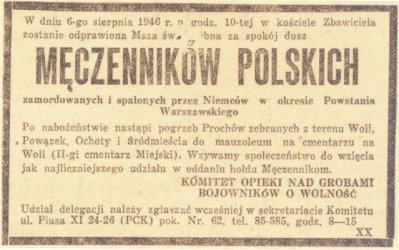
Newspaper advert informing about the holy mass for the souls of Polish martyrs murdered and burned by the Germans during the Uprising (APW)
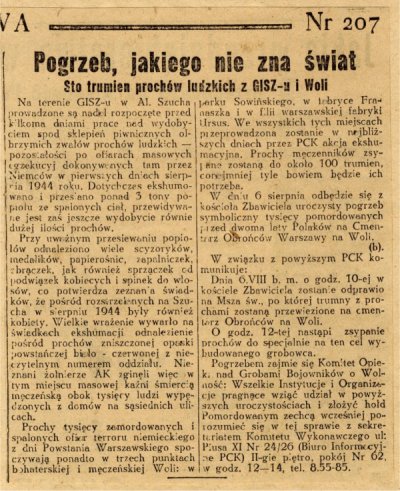
Newspaper advert from July 1946 informing about preparations to the funeral of several tons of human ashes (APW)
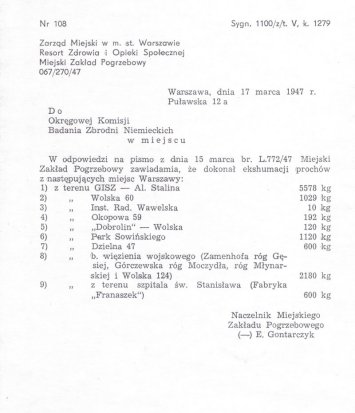
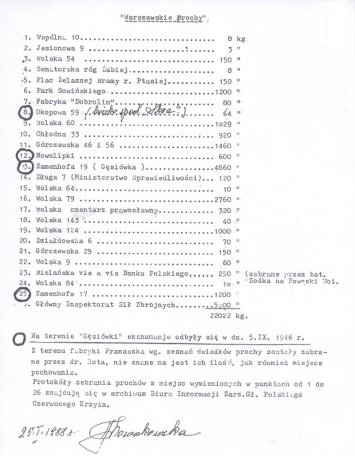
The funeral procession reached the Warsaw Insurgents Cemetery and 12 tons of human ashes were placed in a huge grave measuring 4x6 meteres. The grave was open for some time as ashes from other Warsaw districts: Czerniaków and Żoliborz were buried here as well. All together, there are around 20 tons of human ashes buried underneath the barrow.
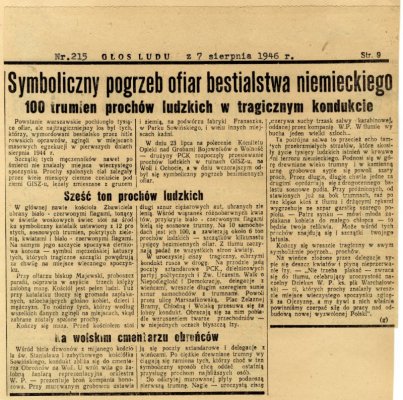
Newspaper article concerning the funeral (APW)
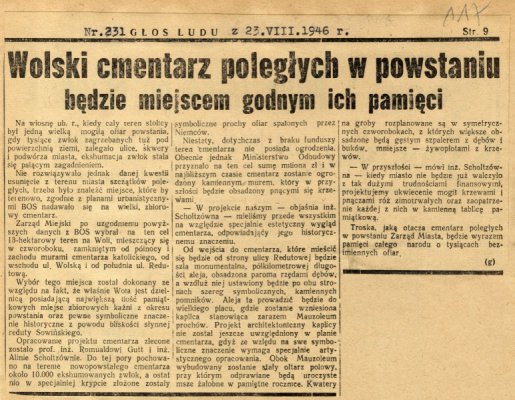
Newspaper advert dated 23.08.1946 regarding the cemetery of the fallen during uprising (APW)
Already at the stage of moving bodies to provisional mass graves in 1945, a number of irregularities were committed. The bottles containing names of the dead placed in the coffins during the Uprising in order to identify the bodies were not transferred to the temporary graves along with the bodies. At the re-exhumation in 1947, this process deepened. The ID's found on the dead were often thrown away. More and more bodies were qualified as unknown.
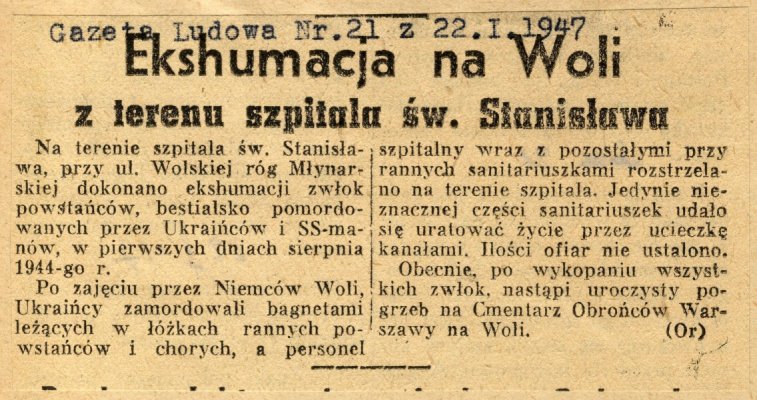
Newspaper article dated 17.01.1947 informing about the exhumation at St. Stanisław hospital in Wola district (APW)
On 18.04.1947 the Union of Participants of Armed Struggle for Independence and Democracy decided to terminate the exhumation of the Polish Home Army soldiers at Krasinscy Garden and refused to bury them at the Powązki Military Cemetery. The Union instructed to bury the Polish Home Army soldiers only in mass graves at the cemetery in Wola.
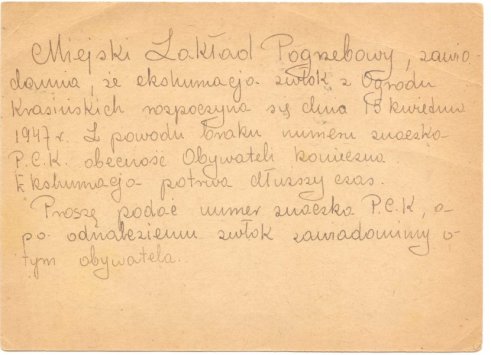
Note dated April 1947 regarding the exhumation at the Krasinscy Garden.
Warsaw Insurgents Cemetery in Wola slowly filled up. The deceased were brought there from 1945 until the beginning of the 50's. They were placed in mass graves anonymously even when the identity of the deceased could be determined. Some identified deceased were entered into the cemetery register. But it did not relate to the Polish Home Army fallen soldiers as those were rather qualified as unknown or civilian.
From the very beginning of the cemetery existence, it was not cared for very well by the State. A journalist in their article dated April 1947 says about the difficult access to the cemetery, muddy surface of the cemetery making difficult getting to the graves, and unburied human remains await burial for weeks. The cemetery did not even have a provisional fence.
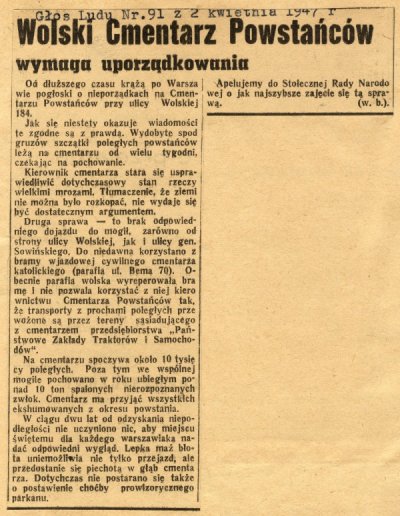
Newspaper article dated April 1947 regarding the condition of the Warsaw Insurgents Cemetery (APW)
War cemeteries are associated with rows of identical graves with simple crosses on them. Every grave bears a plaque with soldier's name, age, rank and unit name. Unknown soldier's name bears inscriptions N.N. (non notus Latin for no name) and the Polish Red Cross registration number. That's how graves at the Powązki Military Cemetery look like, where are laid to rest soldiers of the 1920 campaign and the September campaign, graves of those murdered in Palmiry, soldiers graves at Monte Casino, Verdun, or Arlington National Cemetery.
The cemetery in Wola looks completely different. The Polish communist State diminished the ethos of the Warsaw Uprising and never paid any tribute to the insurgents. Moreover, they oppressed, imprisoned and murdered soldiers of the Polish Home Army. Exactly the same policy was used towards the Warsaw Insurgents Cemetery. Even its name, at some point, was changed to the Municipal Cemetery #2 in Wola district.
The Union of Participants of Armed Struggle for Independence and Democracy, changed its name in 1949 to the Society of Fighters for Freedom and Democracy (ZBOWiD). The Warsaw Insurgents Cemetery and its matters were initially managed by Municipal Department in Wola, and since the 50's it was managed by the Society (ZBOWID).
The Society followed the instructions given by the communist State and its authorities. Without permission, families of the buried were not allowed to put crosses, tombstones or any inscriptions. And the given reason for such prohibitions was decluttering works. The cemetery employees were instructed to remove every tombstone put without permission. The communist State and its administration wanted the buried insurgents to become anonymous. At the same time, the communist State began persecution of the Polish Home Army soldiers, including the Uprising survivors. The cemetery systematically became a ruin. Graves grassed over and crosses rotted. The most difficult cemetery period came in 1947-1953. The cemetery was completely neglected.
Initially, the cemetery occupied the land of 8 hectares (some sources claim it was 13 hectares) and stretched out from the western Wola cemetery wall in direction of Sowiński Street till Redutowa Street. Such space would allow to carry out works in accordance with the Romuald Gutt and Alina Scholtz design, resembling in shape the Palmiry cemetery. However, Society of Fighters for Freedom and Democracy (ZBOWiD) decided to reduce the cemetery territory to only 1.5 hectares. The rest was converted to the square, later on called the Warsaw Insurgents Park. Those decisions changed the look of necropolis and diminished its significance.
For over a dozen years, until the end of the 50's, the cemetery was completely neglected. Among all works included in the Gutt and Scholtz design, only few were completed, namely the main pathway, several paths between sections, and a pond. Few tombstones were only provisional tombstones. Similarly looked the insurgents' graves at the Powązki Military Cemetery. It was a very difficult time for all who survived the Uprising and families of those who fell. It was not allowed to pay tribute and commemorate those who fell for the country in the way they deserved.
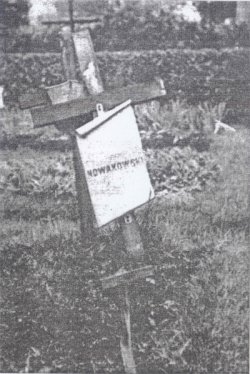
Two rotten crosses support each other like wounded soldiers
The graves and rotted crosses were liquidated and the whole cemetery area was simply
plowed destroying the existing provisional tombstones.
The whole area of 1.5 hectares was divided into 177 rectangular and flat mass graves, grassed over and fenced with stone curbs.
Every grave had a small rectangular plaque made of sandstone with the communist Cross of Grunwald carved on it. The Cross of Grunwald was a high military decoration from the People's Poland era and which meant to replace the War Order of Virtuti Militari. There was an inscription under the Cross of Grunwald: "Fell fighting for freedom during the Warsaw Uprising 1944".
Such a combination could suggest an attempt by the communist authorities to appropriate the Uprising ethos. A few names of the Polish Home Army soldiers, civilians, consciously mixed up with each other were made on the plaques. Apart from that, every plaque carried inscription informing about several dozens and even several hundreds of unknown victims buried at the place.
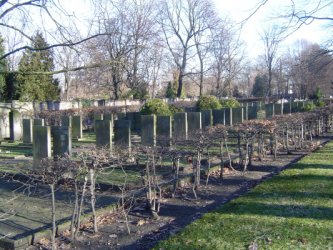
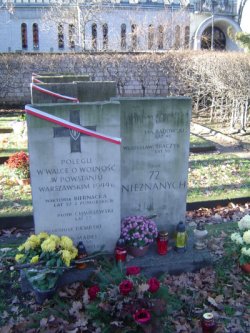
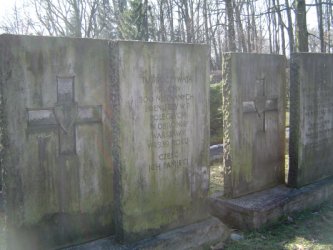
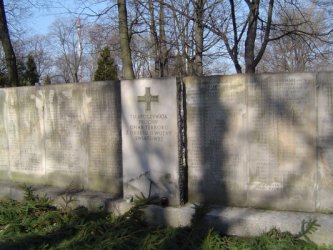
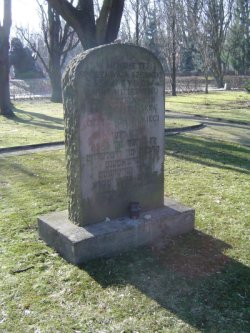
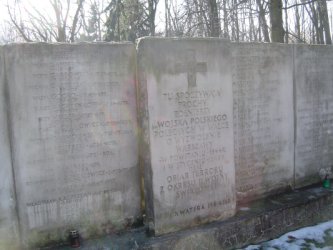
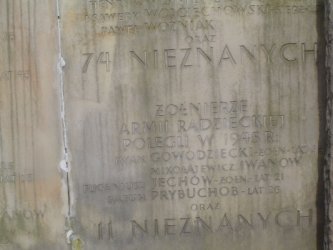
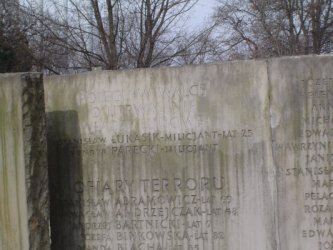
Only one cross made of metal pipes towered over the small cemetery. The cross located on the barrow containing 20 tons of human ashes, had a small stone plaque attached to it which reads: "Here lie ashes of thousands of victims of the German Nazism, murdered and burned in Warsaw in 1944".
The last "illegal" cross disappeared from the barrow containing ashes of the burned Varsovians in 1973. Instead of the cross, thanks to State National Council's initiative, there was erected a massive monument designed and created by a well-known sculptor Gustaw Zemła. The monument showed a dying ancient warrior holding the shield in his right hand. On both sides of the munument are placed barricades built of stone slabs and one of the barricades bears an inscription: "They fell undefeated 1939-1945". The author of the monument's name was a poet, Stanisław Dobrowolski. The monument received good feedbacks, both from the Wola residents and the press.
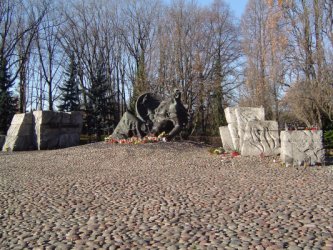
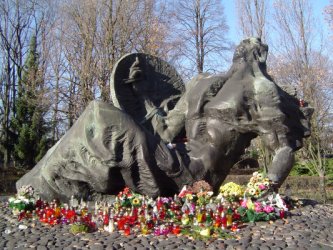
A small plaque was placed on the west side of the barrow, so it was at the back and hardly visible. There is an inscription on the plaque: "Here lie ashes of over the 50 000 Poles who died fighting for freedom of the country against the Nazi Germany invader in the years 1939-1945."
The monument surroundings are paved with the original pre-WWII Warsaw cobblestones. Under the monument, inside the barrow, there is placed 20 tons of human ashes. Very few people who come over for a walk realise that fact and treat this place as it was a park, especially, there is no fence or religious symbols in the area. Rare visitors walk their dogs here and let them approach the monument, school children who come to visit, play on the monument and use its surfaces to slide down.
This situation has not changed for years. Even when the official Warsaw Uprising celebration took place at the cemetery, the mass media informed that it occurred at the monument and not a gigantic grave.
Looking towards the cemetery from Wolska Street, you can see the sandstone slabs placed in rows and separated by a small hedgerow. There is no fence or symbols that would inform that this is a cemetery. Currently, it may only suggest that it is a small countryside cemetery. Additionally, the Grunwald Crosses placed on the slabs may suggests that this a burial place of the communists only.
A plaque put by the Sowiński Street cemetery entry reads: "Warsaw Insurgents Cemetery is a place of commemoration and martyrdom of Polish Nation. At this cemetery are laid to rest the bones and the ashes of heroic people of Warsaw, members of resistance and soldiers fighting for liberation of the capital from German occupation between 1939 and 1945". There was no word about the Uprsing or the Polish Home Army.
When you walk among the mass graves, your perception is changing. The tombstones inscriptions make you aware that next to the insurgents are buried civilians, men and women, children and the elderly. There are no many names on the tombstones, but there is information about thousands and thousands of unknown victims.
At plot #120 located nearby the southern cemetery wall, there is an inscription: Wiesław, Ludmiła, Lech Lurie. On the 5th of August, 1944, Mrs Wanda Lurie, called Warsaw Niobe, was 33 years old and nine month pregnant when she and her 3 children were executed during the Wola massacre. She miraculously survived. Mrs Wanda Lurie was shot twice but lived. She laid quietly for several days under the pile of dead bodies. After that time, she crawled out and manage to get to the St. Wojciech at 74/76 Wolska Street. On the 20th of August 1944 she gave birth to a boy who she named Mścisław. Her three children did not survive the execution and at the moment of death they were respectively 11, 7 and 3 years old.
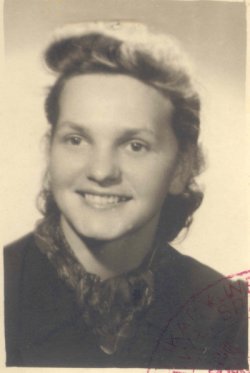
Wanda Traczyk-Stawska, photo taken after her return to the country
Wanda Traczyk-Stawska had also her private mission to complete. Her older brother, Tadeusz, also fell during the Uprising. Her father, former legionnaire of the 1920 campaign and the WWII resistance member wanted his son to have a grave so flowers can be laid on and a candle can be lit. Wanda Traczyk-Stawska was also tasked with that mission.
The cemetery records were kept by the then National Council. The records contained a lot of information which was not disclosed to people who were trying to find their relatives' burial places. A lot of information can also be found in the Polish Red Cross records.
Wanda Traczyk-Stawska started her fight for remembrance. Her father received a letter from Polish Red Cross informing that his son was executed as a civilian and as such was registered under certain Polish Red Cross Number. He also received his son's bloodied ID. Wanda Traczyk-Stawska knew that her brother was a soldier and fought in Powiśle as a member of the "Kryska" group. So she started her private investigation among the former "Kryska" group soldiers. In that way, she managed to establish where exactly her brother fought and the place of his death. His name was listed in the "Kryska" group fallen soldiers record.
Despite those findings, she could not make another step forward. The National Council kept advising her to approach the Polish Red Cross and vice versa. In 1986 she was desperate enough to use a trick and phone the Mayor. During the phone conversation she informed the Mayor she was informed that her brother's body was relocated to the Warsaw Insurgents Cemetery and buried under certain number what was advised to her in writing. And it came out, despite what she was told earlier on countless occasions, her brother, Tadeusz Traczyk, was buried at the cemetery in the plot 34 row I.
Desperate Wanda Traczyk-Stawska wrote a letter to the vice minister of Space and ask to deal with her case and requested her brother's name to appear on the plaque situated at the place where he was buried years ago. The Viceminister happened to be a decent man and took care of the request. As a result of her efforts, Wanda Traczyk-Stawska received an official notification that her brother was a soldier and got killed on the 16th of September, 1944 at 2 Okrąg Street. His name was to be carved on the plaque containg names of the fallen insurgents at the cemetery where he was buried.
And finally, in 1987 an inscription "Private Tadeusz Edward Traczyk ps. "Waluś" 7.08.25 - 16.09.44 the "Kryska" group" appeared on the sandstone plaque with the Grunwald Cross on it. However, the inscription was wrongly made on the plaque in the plot 36 row II instead of the correct plot 34 row I. Just one alley away but still the wrong place.
In the 90's, there was established an unofficial Committee for the Warsaw Insurgents Cemetry in Wola, which later on in 2004 transformed into the Social Committee for the Warsaw Insurgents Cemetery. Time flew and fellow friends passed on, and the mission started in 1947 was not completed. Krystyna Zbyszewska died in 2012. Although the group managed to establish 14 burial places of the unit soldiers, it seemed impossible to commemorate them and put their names on the memorial plaque. All because of bureaucracy and ill will of the clerks.
At some point, Wanda Traczyk-Stawska realised that she practically was the only one to deal with the mission and because of her age she won't be able to complete it. Then she recalled that the Committee Charter mentions that in such a situation, help needs to be requested from the commander. And her commander at the time was the supreme commander of the Polish Armed Forces, the President of Poland.
By the end of 2012, Wanda Traczyk-Stawska wrote a letter to the Chancellery of the President of the Republic of Poland asking to present the Warsaw Insurgents Cemetery case to the President, Bronisław Komorowski. After 3 months from the time the letter was sent, she received a phone call from the Chancellery and was advised that the President can not help in this matter. Wanda Traczyk-Stawska requested a written confirmation of the message which never arrived.
She was in despair and thought that dealing with and completing the mission is beyond her abilities, when after the annual mass for the fallen and the passed away comrades of her unit which is celebrated every year at the St. Cross church, she shared her concerns with her few living members of the Protective Security Unit (Secret Military Publishing Works).
And it came out that one of those people works with the President's relative. The matter was referred to that person and the person conveyed the problem to the President. As a result, Wanda Traczyk-Stawska was invited to Belweder (official residence of the Polish presidents) and reported about her efforts and obstacles that she came across.
Bronisław Komorowski got worried and promised to help move things forward. The President became a patron of the matters related to the cemetery and designated a person to deal with the case. This person, Wiesław Sikorski of the Chancellery of the President, engaged eagerly in the Committee activities helping removing obstacles.
There is a hope that in the near future, when the plaque at the plot #81 will be replaced, the new one will bear names of 14 fallen soldiers of Protective Security Unit (Secret Military Publishing Works). There will be names of 2 girls, 10 boys and 2 young scouts. Three of them will only have their pseudonyms inscribed as their real names were unknown during the Uprising. Their comrades' dreams of 67 years will come true. Their fallen brothers in arms will come out of the shadows of forgetfulness and they will be a place to lay flowers on and light a candle. Although their bodies are buried somewhere else in other parts of the cemetery, this will be the place where their names will be commemorated. Thanks to determination and stubbornness, and in spite of obstacles, Mrs Wanda Traczyk-Stawska carried out the order given years ago and completed her mission.
Not much changed after regaining the independence in 1989. Andrzej Osęka, a journalist of "Gazeta", wrote an article in 1994 titled "Camouflaged cemetery". The author claimed that everything was done to make sure that the biggest necropolis of Warsaw remains unknown and dull. The place does not resemble soldiers' and insurgents' place of eternal rest at Powązki cemetery. Combined forces of communist secret police and bureaucracy consciously and gradually had been tearing apart the families' and comrades' connections with the insurgents graves, until it became a dull place sealed with the Society of Fighters for Freedom and Democracy's marks.
Nothing was happening at the Warsaw Insurgents Cemetery for years. Great efforts were made by a group of combatants, former women soldiers of Polish Home Army linked with the necropolis in Wola, in order for the cemetery to come out of the shadows of forgetfulness. The group, represented by Wanda Traczyk-Stawska, received support from the Management Board of the World Association of Home Army Soldiers. Their common efforts started bringing positive results.
During the 50th Warsaw Uprising anniversary on 1st of August, 1994, for the first time since dozens of years, an official drumhead service was carried out by Bishop Sławoj Leszek Głódź, Catholic bishop of the Polish Army. The service took place at the field altar built on the main pathway, between the eastern wall of the Religious cemetery in Wola and the barrow with the Fallen Undefeated memorial standing on it.
In 1995, the Warsaw Insurgents Cemetery was recognised as a listed monument and as such was added to the Record of monuments and that fact supposed to protect the place from devastation
Administration of war cemeteries in Poland was taken over by Council for the Protection of Struggle and Martyrdom Sites in 1998 and that meant better times for the cemetery. The Council, led by Mr Andrzej Przewoźnik, assessed the necropolis and confirmed the Warsaw Insurgents Cemetery is indeed a war cemetery and qualifies and should be protected by the State and its administration in accordance with the Act of 28 March 1933 on graves and war cemeteries.
The Council sent its suggestions in terms of scope of works to the Mazovian Voivode and those included:
1. replacing the main information plaque
2.erecting a cross in the central area of remembrance
3.fencing the area from Sowiński Street as well as putting gates from Sowiński Street and Wolska Street.
Implementation of the suggestions required certain funds. At the time, Council for the Protection of Struggle and Martyrdom Sites was heavily involved in the restoration works at the Cemetery of the Defenders of Lvov. The suggested works gradually were carried out.
In 2001, the Fallen Undefeated memorial standing on the barrow containing ashes of 50 000 people, in harmony with the World Association of Polish Home Army Soldiers combatants' proposals, was supplemented with the religious and insurgency symbols. The shield of dying warrior and the barricade was supplemented with anchors, 'Poland Fighting' symbol, and two barricades had crosses assembled and an inscription "Warsaw Uprising '44" reminding that this place is a gigantic grave.
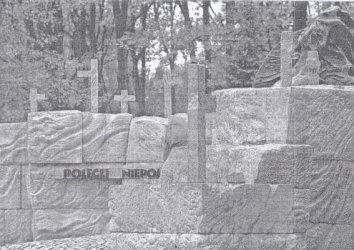
The devastated crosses on barricades
Unfortunately, the plaque was not moved and is still at its original location and is still placed at the west side which in fact discourages people to get familiar with the content.
"The Warsaw Insurgents Cemetery was founded 1945 and is the biggest Uprising Necropolis. The Warsaw Uprising began on the 1st of August, 1944 and capitulated on the 2nd of October, 1944. Here lie the human remains of around 104 000 people. In mass graves buried around 100 000 bodies and ashes of civilian inhabitants of Warsaw and Polish Home Army soldiers and soldiers of other unit fallen in combat, murdered in mass executions and burned during the 63 days of Warsaw Uprising.
The remains and the ashes of the fallen exhumed and relocated from various Warsaw cemeteries. First burial took place on 30th of November, 1945 and then remains found at exhumation at Mokotowska Street #24/29 were laid to rest.
Between 1946 and 1947 and later, this place was a burial ground for the exhumed remains from various Warsaw districts.
At the cemetery were also buried 3 526 soldiers of the Polish Army both the fell and the died of wounds in September 1939 as well as 231 soldiers of the Soviet's Polish First Army both the fell and the died of wounds in years 1944-1945.
The building of the cemetery in its current appearance commenced at the beginning of the 60's in last century and according to design by a sculptor, Tadeusz Wyrzykowski.
In 1973, within the burial ground hiding the ashes of around 50 000 people, there was erected a memorial, the Fallen Undefeated designed by a sculptor, Gustaw Zemła."
In 2004, on the axis of the main pathway, by the Wola cemetery wall, there was erected a stone altar decorated with the cross and the anchor - 'Poland Fighting' emblem. The altar was erected on the initiative of the World Association of Home Army Soldiers and the Social Committee for the Warsaw Insurgents Cemetery. The altar was designed by Tadeusz Wyrzykowski and officially consecrated during the drumhead service on the 1st of August, 2004.
The monument is directly linked with the Warsaw Insurgents Cemetery as all the victims mentioned on the monument are buried at the cemetery situated in Wola district.
In year 2009 in the main pathway of the Warsaw Insurgents Park, nearby the Fallen Undefeated monument, there was unveiled a stone plaque in honour of the Grey Ranks scouts fallen during WWII and Warsaw Uprising.
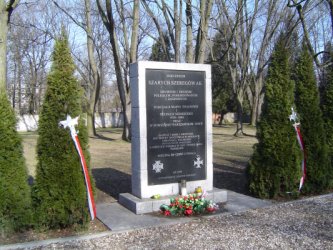
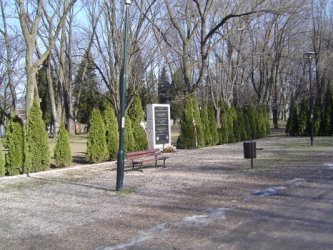
Since the creation of Social Committee for the Warsaw Insurgents Cemetery, the committee has been collecting names of people buried at the cemetery as they are intending to put their names on the Memorial Wall. The committee has also been making sure that the cemetery has the appropriate status. Another example of their activity is making efforts to replace the Grunwald crosses currently placed on the tombstones with the religious and the Uprising symbols, fence the necropolis, as well as collecting money to fund the cemetery gates and plaques which would be situated next to the gates and inform about the cemetery history. The committee has also active co-operators such as the Society of Wola's Friends with their president, Mr Michał Szczerba, a member of Parliament.
After several dozens of years, the committee actions started to bear fruit. Renovation works already started and are scheduled finished for the 70th anniversary of the Uprising. The committee actions are supported by the Mazovian Voivode, Council for the Protection of Struggle and Martyrdom Sites and Wola District Council. In phase one, carried out in 2011, started and finished the design works, as well as preparations to renovation works at the Warsaw Insurgents Cemetery.
The following announcement was issued in July 2011:
"The Council for the Protection of Struggle and Martyrdom Sites and Social Committee for the Warsaw Insurgents Cemetery at the World Association of Home Army Soldiers, proudly informs that the design works and preparations to renovation works at the Warsaw Insurgents Cemetery have concluded. The majority of the Poles, not only Warsovians, when thinking about the victims of the heroic uprising, think about the Powazki Cemetery. And to tell the truth, the biggest uprising cemetery is located in Wola as the cemetery entombs ashes of 104 000 soldiers of Polish Secret State and, as heroics as the soldiers, Warsaw civilians, who all died in defence of the Country.
We are facing another stage of our activities, which is carrying out the works in accordance with the chosen architectural concept. And the concept is to reinstate the significance of this place and honour the victims died on the altar of the Country.
In this way, we have an opportunity to complete a very long, almost 66-year long, period of the cemetery existence, which was not always easy for the fallen relatives and the combatants, brought a lot distress and irritation as they witnessed conscious forgetfulness and negligence. Closing this period is not only our debt which we owe to those, who lie to rest in this place. It's also our debt to their living and dead brothers in arms, to all combatants of the World Association of Home Army Soldiers, to families and loved ones of the fallen and the murdered.
We wish to bring back the religious and Uprising symbolism. Provide a gate which will match the significance of this place. Replace the tombstones and tide up the greenery. So-far- determined-names of over 3 300 fallen and murdered will be placed on the symbolic Wall of Remembrance. There is a great need to identify and determine names of all the victims which ashes are buried at this cemetery. Therefore we appeal to all fellow countrymen, living in the country and abroad, for any possible help in order to complete this task.
Thanks to the agreement between the Council for the Protection of Struggle and Martyrdom Sites, the President of Warsaw and the Mazovian Voivode, the intensive renovation works will be carried out in order to bring back an adequate character to this world's exceptional necropolis and make possible a decent and solemn celebration of the 70th Warsaw Uprising anniversary.
Signed by:
- Mr Andrzej Krzysztof Kunert: the Secretary of the Council for the Protection of Struggle and Martyrdom Sites
- Mrs Wanda Traczyk - Stawska, Social Committee for the Warsaw Insurgents Cemetery at the World Association of Home Army Soldiers"
In 2011, the Committee's activities were acknowledged by the rector of the University of Warsaw, prof. dr hab. Katarzyna Chałasińska-Macukow, who assumed Honorary Patronage over the Committee's activities.
In 2012 the Warsaw Insurgents Cemetery became a listed monument under the number A-1057. Hopefully, it may allow to apply and receive European Union funds for renovation.
In 2004, after unveilling the stone altar with the cross and the anchor on it, the Warsaw Uprising anniversary celebrated at Warsaw Insurgents Cemetery became official and as such were entered into the official Warsaw Uprising celebrations catalogue. Since 2005, every 1st of August at 7 p.m. at Warsaw Insurgents Cemetery takes place an ecumenical prayer along with laying wreaths and flowers and lighting candles on graves.
On 1st of August, 2012 at 6.30 p.m. by the Fallen Undefeated memorial, occurred an official celebration commemorating the defenders and residents of the Wola district who lost their lives in August 1944. A drumhead service was carried out by priest commander Janusz Bąk. The service was carried out in the dark and upright positions on feet. The celebration was lighted only by glimmering candles and candlesticks.
On 1st of August 2013, the anniversary celebration was exceptionally solemn. Apart from insurgency combatants and residents of Wola district, the celebration was honoured by the presence of the President of Poland, the President of Warsaw, representatives of the Sejm and Senate, archbishop Nycz, priest commander Janusz Bąk and parish priests of the Wola parishes. After the official part, archbishop Nycz carried out a service concelebrated by priest commander Janusz Bąk and the parish priests.
Thanks to the Chancellery of the President of Poland's involvement, Insurgency combatants and Varsovians could participate in an unique happening, a service for the deceased buried at Warsaw Insurgents Cemetery.
After the service, a theatre group "Varsovians" took the stage and presented a medley of insurgency and partisan songs. The President of Poland, Bronisław Komorowski, was present to the very end and listened to the concert with interest.
Since the President of Poland had assumed Honorary Patronage over renovation works at the Warsaw Insurgents Cemetery, the works moved forward with an accelerated pace. Exchange of tombstone at sections started in 2012. At first, there were replaced tombstones at so called big sections and this phase was dealt with by the Mazovian Voivodeship Office with personal involvement of the Mazovian Voivode, Mr Jacek Kozłowski, who for that purpose, allocated funds of 2 200 000 złotych.
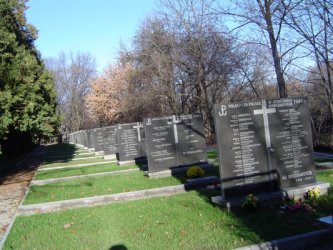
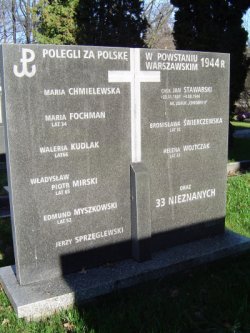
Warsaw Metropolitan Curia will deal with recreation of the border wall between the Religious Cemetery and the Warsaw Insurgents Cemetery. Works related to this project will be overseen by Council for the Protection of Struggle and Martyrdom Sites, which will also oversee replacing works of the tombstones at so called small sections situated by the cemetery wall. The cost of works is 2 500 000 złotych.
Works at the Wolska Street entry, which will change the appearance of the entry, are in preparation stage and according to the schedule, will be performed at the same time as the renovation works at the sections. This part of works will cost 2 500 000 złotych and will be funded by the Council for the Protection of Struggle and Martyrdom Sites.
The Wola District Council, among other tasks, will deal with roses replacement on the scarp and renovate the alley leading to the necropolis from Sowiński Park. The Council is also planning tidying up the cemetery area from Wolska Street.
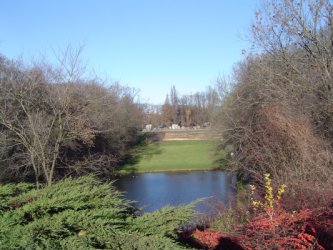
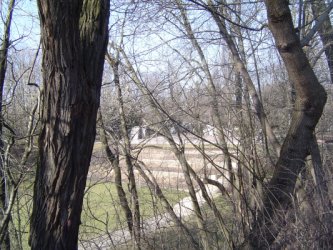
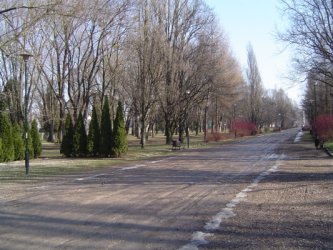
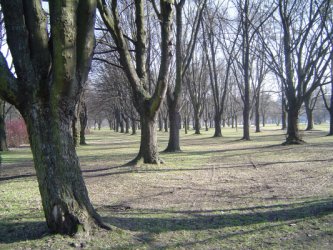
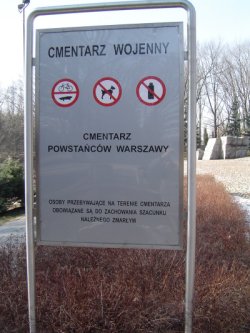
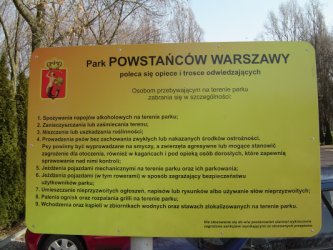
The renovation works are scheduled to finish before the 1st of August, 2014, before the 70th Warsaw Uprising anniversary commence. After long years of aversion and non-existence in people's minds, the Warsaw Insurgents cemetery will change and regain its position and significance as one of the most important history monuments.
In July 2013, on the initiative of the Society of Friends of Wola, there was organised a field exhibition "Wola Pamięci - Cmentarz Powstańców Warszawy na Woli". In order to create the exhibition, there were used archival materials of four Warsaw archives: the State Archives of the Capital City of Warsaw, the Central Archives of Historical Records, the Archives of New Files and the National Digital Archives.
The exhibition organisers: the Society of Friends of Wola, the Board of Directors of State Archives and the State Archives of the Capital City of Warsaw.
Exhibition partners: the Social Committee for the Warsaw Insurgents Cemetery at the World Association of Home Army Soldiers, the House of Meetings with History, the Archives of New Files, the Central Archives of Historical Records and the National Digital Archives.
The exhibition was dedicated to the Warsaw Insurgents Cemetery in Wola, the biggest, this type, necropolis in Europe. At the cemetery are laid to rest the remains of over 100 000 deceased, soldiers and civilians, those who fell fighting for freedom of Poland and those were murdered and burned by the Germans during Warsaw Uprising, and those exhumed from the streets of Warsaw after WWII.
Exhibition told the story of the cemetery, its foundation, designing stages. Also showed fates of those who are buried at the cemetery and circumstances of their death. The exhibition made visitors familiar with the complicated and tragic fate of Wola, the district where the cemetery is located.
The exhibition was showed on 1st of August 2013 at 7.30 p.m. at the Warsaw Insurgents Cemetery, and from 2nd of August to 10th of September, 2013 was showed at different location at ks. Jan Twardowski Square (a priest and a soldier of the Uprising), situated along Krakowskie Przedmieście Street. The exhibition was very popular and was visited by many visitors.
The Polish Television Channel 2 on 19th of August, 2013 at 11.50 p.m. presented a documentary, made in 2008, by Michał Rogalski and titled "12 tons - all of them are there"
The documentary tells a story about unknown heroes of Warsaw Uprising. It was made on the base of stories told by witnesses of the Wola massacre and prisoners of the transition camp in Pruszków.
Individuals appearing in the documentary: Wiesław Kępiński, Krystyna Teter, Halina Bielecka, Krystyna Błażyńska-Kowalska, Krzysztof Kąkolewski, Tadeusz Klimaszewski, Wanda Lewicka, Danuta Leśniewska-Sławińska, Mścisław Lurie, Wanda Lurie, Elżbieta Piechocka, Eulalia Rudak, Hanna Siniecka, Maria Stypułkowska-Chojecka, Eugeniusz Trepczyński, Bożenna Trojan, Paweł Dukielski. Majority of the above people personally witnessed the occurrences in Wola in 1944.
On 2nd of November, 2013 at the House of Meetings with History, on the initiative of the Social Committee for the Warsaw Insurgents Cemetery and the Society of Friends of Wola, occurred a meeting summarising the exhibition "Wola Pamięci - Cmentarz Powstańców Warszawy na Woli". The honorary guest of the meeting was the President of Warsaw, Hanna Gronkiewicz-Waltz. At the meeting, the president informed that a decision was made to restore the cemetery to its original size which means that 6.5 hectares, taken away in the 50's, will be returned to the Warsaw Insurgents Cemetery. The total cemetery area will now occupy 8 hectares. The new Warsaw Insurgents Cemetery will consist of the current Warsaw Insurgents Park situated between Sowiński Street and Redutowa Street and that means coming back to the original cemetery design of Romuald Gutt and Alina Scholtz.
There will be announced a competition co-organised by the Association of Polish Architects for the design of the cemetery and the nearby park development. The competition contestants will have a chance to present their ideas regarding fencing, gates, Memorial Chamber, etc.
The Memorial Wall will be erected in the Warsaw Insurgents Park and the surface of the Wall will contain names of the deceased buried at the cemetery. It needs to be remembered that among the 104 000 deceased buried at the cemetery, the majority is represented by civilian victims of the Uprising.
In order to illustrate the number of people buried at the cemetery, the Wall should bear names of the identified deceased and names of those who were laid to rest as unknown and the unknown should be marked NN along with the Polish Red Cross registration number, if known. And then it will be visible how many heroes of the Insurgency are buried at Warsaw Insurgents Cemetery. If we were to use the same criteria as those used by the Warsaw Uprising Museum while building their Memorial Wall, the Wall at the cemetery would be 1.115 meters long.
Wanda Traczyk-Stawska, present at the meeting and the person in charge of the Social Committee for the Warsaw Insurgents Cemetery, happily stated that her mission is finally coming to an end. She also proposed that every 2nd of October becomes a Day of Remembrance of civilian residents of Warsaw and the Day will be celebrated in a similar way that the 1st of August is the day of remembrance of the Warsaw Insurgents.
In order to accomplish the idea of Memorial Wall, a project was started with the following participants: Council for the Protection of Struggle and Martyrdom Sites, Mazovian Voivodeship, Warsaw Uprising Museum and Social Committee for the Warsaw Insurgents Cemetery. There was prepared a special survey dedicated for those whose relatives and loved ones are buried at the cemetery. It is also dedicated to their friends and neighbours. Every information is priceless, family stories, the burial and/or exhumation eye witness stories. Information obtained in that way may lead to the identification of the so far unknown victims and that allow to inscribe their name on the Memorial Wall.
For many years, the Social Committee for the Warsaw Insurgents Cemetery has been collecting names of the buried at the cemetery. The scout movement always supported those activities. Just recently, the Committee started a cooperation with a television program "Human losses and victims of oppression under the German occupation".
There was open a bureau at the Warsaw Uprising Museum which is collecting information about the fallen, the passed away and those who went missing during the Uprising. The survey may be downloaded from the museum website and the completed form may to be sent via email: biuro@1944.pl.
The survey may also be collected and completed at the Museum at the Room of the Warsaw Museum Combatant (building C, first floor, room 105). Information may also be left via phone calling on (22) 539 79 36 or faxed (22) 539 79 24.
The survey may also be sent electronically to the Social Committee for the Warsaw Insurgents Cemetery via email: cpw1944@gmail.com
When the Memorial Chamber is built at the Warsaw Insurgents Cemetery area, the Chamber will resemble the one in Palmiry, it will be a place where visitors, not only from Warsaw, but also tourists, will have a chance to find out about the Warsaw struggle and fight for freedom during the German occupation, as well as shameful practices in the after-WWII history of Poland done in order to falsify the history of the Warsaw Insurgents Cemetery. This will be the place where souvenirs of the mass murder victims could be collected and presented. Every single class from all the Warsaw schools should compulsorily visit the cemetery and learn history on site.
Modern Warsaw is a city of many new Varsovians who have no roots in this place. Such roots can be defined by graves of their loved ones and relatives. Anonymity of thousands of people laid to rest at the Warsaw Insurgents Cemetery may become some sort of link with Warsaw and its history and create a chance for them to gain their own identity. If they feel Varsovians, they will be able to come and visit the cemetery in August and November, light a candle and lay flowers by the barrow where ashes of so many thousands of inhabitants of this invincible city are buried.
And the shadows of those who are buried here anonymously for several dozen years will finally come out from the shadows of forgetfulness and will be kept in memory of both, recent and future generations.
The renovation works, since 2012 under the auspices of the President of Poland, Mr Bronisław Komorowski, gradually continued. Most of the tombstones in selected plots were replaced before the 70th anniversary of the Uprising. The new tombstones are decorated with the crosses and the anchor, the symbol of "Poland Fighting". The inscriptions clearly relate to the fact that at the cemetery are buried individuals fallen during the Warsaw Uprising both, soldiers and civilians.
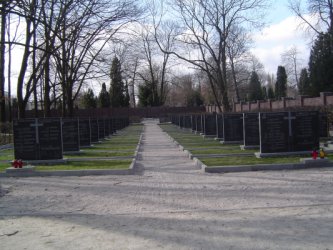
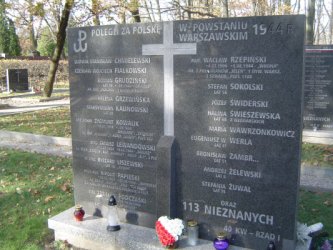
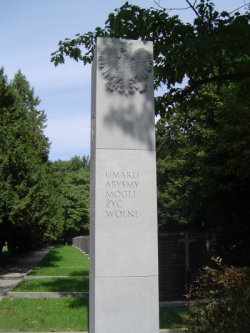
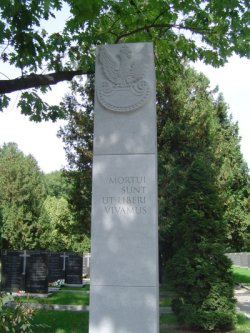
Under the cast of arms of Warsaw there are verses:
I humbly bow my forehead to your stones,
Cos in every stone there is someone's charmed tear,
And someone's blood is reddening on every stone!
And when they thought, that they will lay you in the coffin,
That you will fall down, buried with bloody soil,
It was you with smile so boldly, so proudly
Carried your martyr's cross, oh Warsaw
O, miasto moje! O, Warszawo święta!
Skroń zniżam kornie do twoich kamieni,
Bo w każdym głazie czyjaś łza zaklęta,
I krew się czyjaś na każdym czerwieni!
A gdy myśleli, że cię złożą w trumnie,
Że padniesz, ziemią przysypana krwawą,
To ty z uśmiechem tak hardo, tak dumnie
Męczeński krzyż swój dźwigałaś, Warszawo
Underneath the anchor, the symbol of 'Poland Fighting', there are verses:
It is like, my boy, you would lay it
On all graves, both old and recent ones,
Where soldiers sleep who died for freedom.
Stand here, boy, and take an oath,
So you will always love this grave,
And will not forget to mention in your prayers
Those, who died in the holy battles.
Na tę mogiłę, gdy składasz kwiat,
To tak, mój chłopcze, jakbyś go kładł
Na wszystkie groby, dawne i świeże,
Gdzie śpią za wolność legli żołnierze.
Stań tutaj, chłopcze, i uczyń śluby,
Że będziesz zawsze kochał ten grób
I nie zapomnisz wspomnieć w modlitwach
Tych, co zginęli w najświętszych bitwach.
Between the gates, there has been placed a granite slab with a writing: "The Cemetery of Warsaw Insurgents". It undoubtedly indicates where the cemetery border lies and it separates the holy ground from the alley.
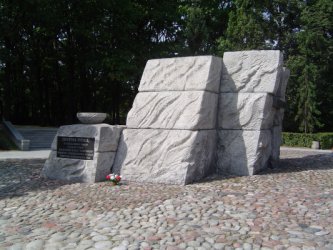
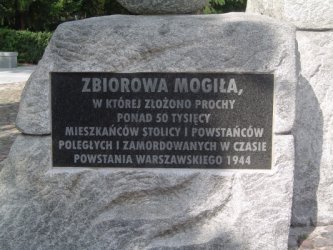
The 70th anniversary of Warsaw Uprising at the Warsaw Insurgents Cemetery was particularly solemn. Among many honourable guests was also the President of Poland, Mr Bronisław Komorowski, and his wife.
An ecumenical mass was celebrated by the barrow where are laid to rest tons of ashes of the murdered and burned Varsovians, above which was erected a monument the Fallen Undefeated. There were also speeches of the officials and the wreath and flowers laid in memory of the dead.
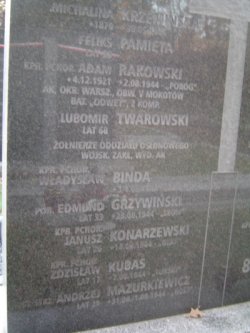
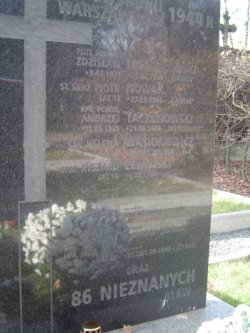
After the anniversary celebration, cleaning works continued. The tombstones were replaced in the small sections behind the barrow, and the cemetery fence was renovated in cooperation with Roman Catholic Archdiocese of Warsaw.
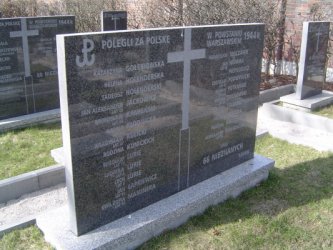
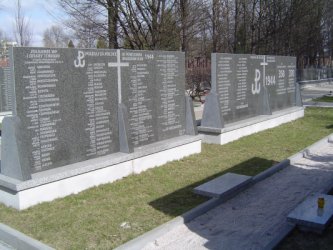
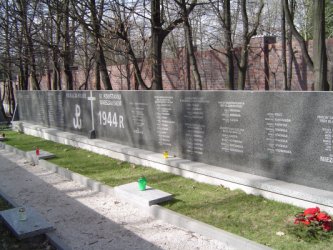
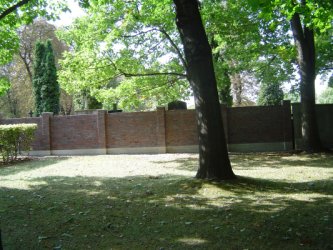
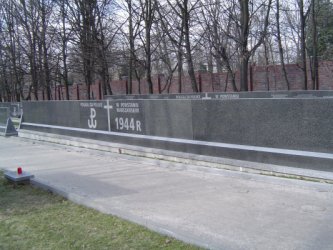
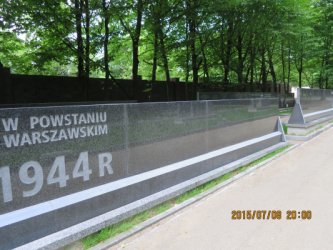
Regretfully, considering the amount of funds that was involved in the project, the quality of completed works is questionable and for example the writings on the tombstones have already started to fade and some of them are almost unreadable. And all of this makes us wonder how it will look in a couple of years.
The contest met a lot of interest, received 107 entries and on the 8th of May, 215 the jury consisting of:
- Marek Mikos - Office of Architecture and Spatial Planning
- Jakub Wacławek - reporting judge, Association of Polish Architects
- Wanda Traczyk-Stawska - the Social Committee for the Warsaw Insurgents Cemetery
- Tadeusz Barucki - Association of Polish Architects
- Maciej Kuryłowicz - Association of Polish Architects
- Anna Ginter - Wola District Office, Department of Architecture
- Wojciech Wagner - Office of Architecture and Spatial Planning, the Aesthetics Department of Public Space
- Ewa Nekanda-Trepka - Museum of Warsaw
- Piotr Oleńczak - Mazowiecki Provincial Office
- Adam Siwek - Council for the Protection of Struggle and Martyrdom Sites
assessed and rated the sent in entries and awarded the following prizes:
1st Prize: 70 000.00 złotych and an invite to negotiate in the mode of a free-hand order of the implementation of the pavilion's implementation project, work #30, authors: Piotr Bujnowski, Kalina Jędrak, Maciej Koczocik, Krzysztof Makowski, Martyna Rowicka
2nd Prize: 50 000 złotych - work #96, authors: Karol Żurawski and Maciej Łuczak
3rd Prize: 30 000 złotych - work #25, authors: Mikołaj Kwieciński and Michał Adamczyk
Commendation: 8 000 złotych - work #17, authors: Caps Architekci Korneluk, Parysek Słowik Sp. z o.o.
Commendation: 8 000 złotych - work #22, author: Mikołaj Zdanowski , Jan Pawlik, Piotr Straszak
Commendation: 8 000 złotych - work #34, authors: Jakub Magoń Pracownia Architektoniczna
Commendation: 8 000 złotych - work #59, authors: Romuald Loegler i Małgorzata Postrach
Commendation: 8 000 złotych - work #102, authors: Paweł Natkaniec, Karol Olechnicki, Maciej Faber, Piotr Łatak, Michał Karol
Honourable commendation: work #66, zespół author: Ewa Trafna
Honourable commendation: work #76, author: Tomasz Wirchanowski.
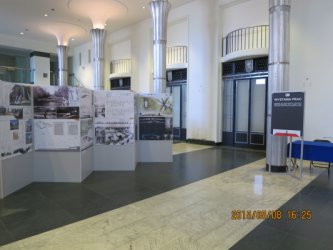
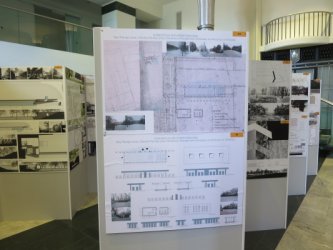
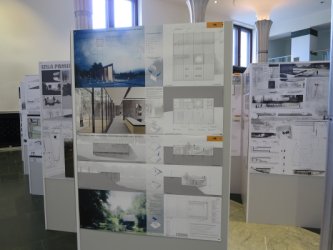
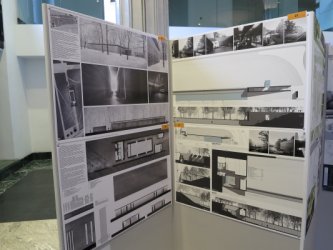
The project proposes a simple reinforced concrete structure among the trees. The pavilion walls will be a meter thick. There will be two rooms inside, one of them, bigger one, for exhibitions and the other room, smaller one, for educational purposes. The floor will be made of thick metal plates which will provide a specific sound while walking on it and footwear tracks will be deposited on the surface. The Memorial Wall will be located next to the pavilion and will be showing names of all deceased buried at the cemetery. Until now, only small percentage of the buried was identified and named, namely 3 300 out of the 104 000 buried at the cemetery.
On 5th of August 2015, an exhibition "Keep them in our memory" was open in the Insurgents Park in Wola. The Park is situated just next to the Warsaw Insurgents Cemetery, along Wolska Street and between Sowińskiego Street and Redutowa Street.
The exhibition was organised on the initiative of the Warsaw Uprising Museum and paid tribute to civilian victims of the Uprising who died or got killed during the 63 days of the Uprising.
And the sky will tie itself up with the black cloud,
Get up noiselessly, just like children do,
and bring the ear conch to the walls.
You will just sigh, and it'll get you
from the bottom with a keyboard of the floors
in the humming and murmur of a swirling blizzard
the painful voice of the past lives choir.
"Ivy voices from under the ruins and rumbles
we climb at night on roofs and sleep,
to you, Warsaw, you dream in our dreams,
humming in Septembers our funeral lament ".
- I ran to the bakery to get a bread in the morning
(and bread is awaited there at home),
and I'm lying helplessly with the basket,
just around the corner, unknown to anyone ...
I was just grabbing a hand grenade,,
to welcome the tanks with it accurately,
the ground was cracked, plowed -
suddenly the world got darkened mortally ...
We both took out on the stretchers,
yet we covered his legs with a blanket,
cause they were shouting around that the fire ...
And I was writing on a piece of paper: "My Dear
"
"Ivy voices from under the ruins and rumbles
we climb at night on roofs and sleep,
to you, Warsaw, you dream in our dreams,
humming in Septembers our funeral lament "
Listen to those mournful voices fervently,
before the morning dawn will silence them in heaven
and a new city in a stretched bowstring
of triumphant days will bury again.
Listen to those voices, cause that's why happily,
Was saved in a tragic need,
So you break your everyday bread more fairly,
And live better for those and for yourself.
Nocą, gdy miasto odpłynie w sen trzeci,
a niebo czarną przewiąże się chmurą,
wstań bezszelestnie, jak czynią to dzieci,
i konchę ucha tak przyłóż do murów.
Zaledwie westchniesz, a już cię doleci
z samego dołu pięter klawiaturą
w szumach i szmerach skłębionej zamieci
minionych istnień bolesny głos chóru.
"Bluszczem głosów spod ruin i zgliszcz
pniemy się nocą na dachy i sen,
tobie, Warszawo, w snach naszych śnisz,
nucąc wrześniami żałobny nasz tren".
- Biegłam rankiem po chleb do piekarni
(a chleba dotąd czekają tam w domu),
A ja leżę z koszykiem bezradnie,
tuż za rogiem, nie znana nikomu...
Właśnie ręką chwytałem za granat,
żeby czołgi przywitać nim celnie,
ziemia była spękana, zorana -
nagle świat mi się zaćmił śmiertelnie...
- Myśmy obie wyniosły na noszach,
jeszcze kocem okryły mu nogi,
bo krzyczeli dokoła, że pożar...
Ja na świstku pisałam: "Mój drogi..."
"Bluszczem głosów spod ruin i zgliszcz
pniemy się nocą na dachy i sen,
tobie, Warszawo, w snach naszych śnisz,
nucąc wrześniami żałobny nasz tren".
Słuchaj tych głosów żałobnych żarliwie,
nim brzask poranny uciszy je w niebie
i nowe miasto w napiętej cięciwie
dni tryumfalnych na nowo pogrzebie.
Słuchaj tych głosów, bo po to szczęśliwie
ocalon został w tragicznej potrzebie,
byś chleb powszedni łamał sprawiedliwiej
i żył za tamtych i za siebie lepiej.
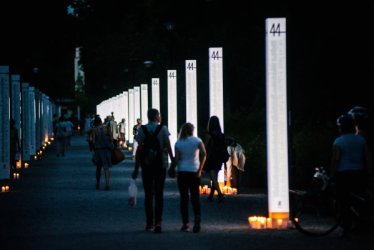
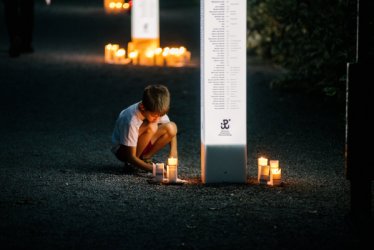
Exhibition by night (photography: Maksym Rudnik)
Historical consultation: prof. Tomasz Szarota, dr hab. Michał Kopczyński, dr Maciej Wyrwa.
Graphic and architectonic design: Justyna Czerniakowska, Ola Kot, Michał Peszka.
Execution: ABN Studio "Inastaltech" Adamiec Dominik.
Initially, the exhibition supposed to be one-off happening and shut by the beginning of November 2015. However, after receiving a great deal of positive feedbacks, the Museum of Warsaw Uprising decided to carry on in the coming years. The exhibition shuts in the autumn and reopens in the spring.
The Warsaw Uprising Museum is striving to seek and find missing information and names and update their records. People who may have help in this matter are kindly requested to visit the Museum website and fill in the form. Alternatively, they may contact the Archives of the Warsaw Uprising by calling them on 22 539 79 31, via email: ofiarycywilne@1944.pl or visit them at Grzybowska Street 79.
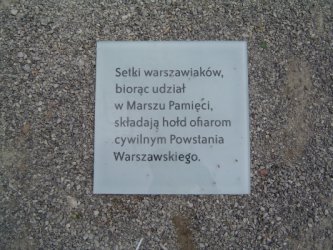
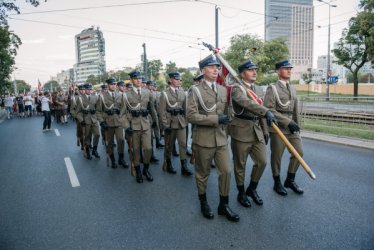
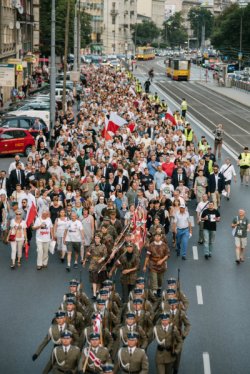
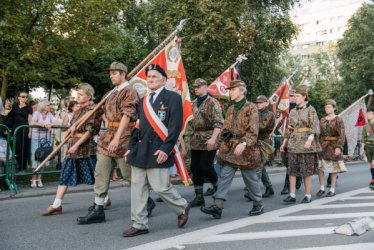
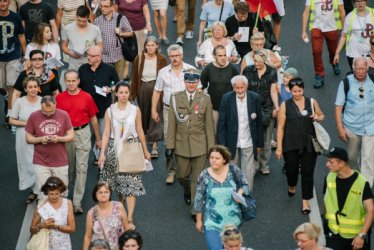
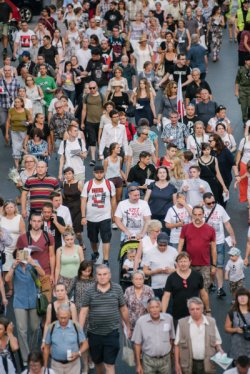
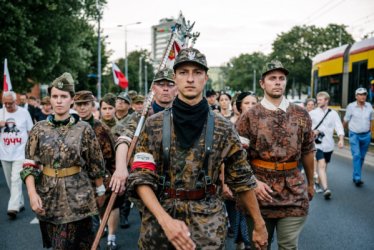
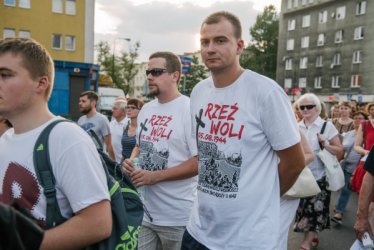
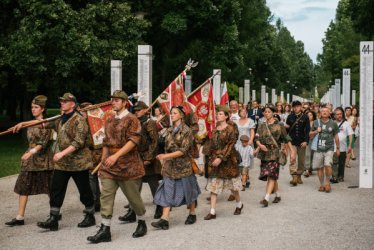
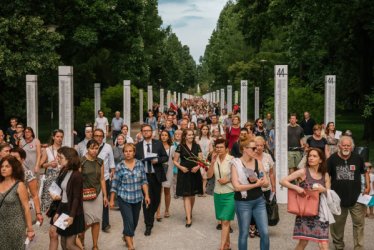
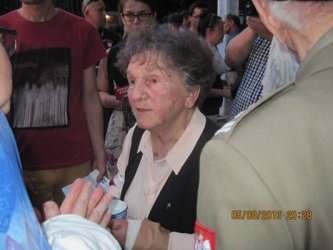
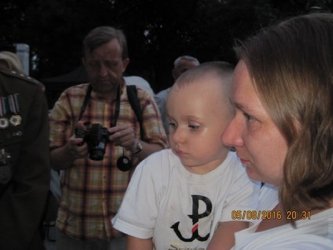
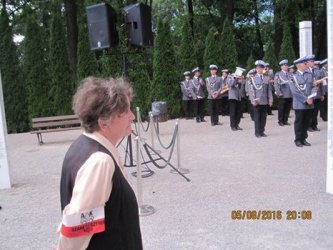
March of Remembrance (photography Maksym Rudnik
In May 2017, during the celebration of Mother's Day, a Monument of Mother was unveiled in the Warsaw Insurgents Park located at the Warsaw Insurgents Cemetery in Wola.
Although wars are fought by soldiers, their victims are mainly civilians. That was the case during World War II in Poland, especially in Warsaw. These days, we are facing exactly the same situation in Syrian city Aleppo or the Somali civil war.
Mothers' courage and heroism during war time becomes symbolic. Many of them had to come to terms with death of their child. Jadwiga Romocka lost two sons in the Uprising, 21-year-old Andrzej ps. "Morro" and 19-year-old Jan ps. "Bonawentura", the both were soldiers of the Polish Home Army battalion "Zośka". The biggest tragedies seem to be a triviality comparing to what Wanda Lurie, Warsaw Niobe, went through. She was nine-month pregnant when along with other residents of Wola was herded to the Ursus factory. At the factory, Germans killed her three children: 11-year-old Wiesław, 6-year-old Ludmiła and 3-year-old Lech. Wanda Lurie miraculously survived the execution as was shot in the head and both legs. After two days of laying under the corpses, she managed to got out from under the pile of dead bodies and got to St. Wojciech Church at Wolska Street. Two weeks later she gave birth to a baby boy named Mścisław.
The soldiers' struggle is commemorated by over a dozen of memorials and hundreds of plaques. The heroism of mothers, who lost their children in the course of war, so far was not commemorated in Warsaw.
The Social Committee for the Warsaw Insurgents Cemetery decided to change that situation. The Committee looks after the biggest Warsaw necropolis where, among others, Wanda Lurie's children are buried. On the initiative of Wanda Traczyk-Stawska ps. "Pączek", who is charge of the Committee, a monument was gifted to mothers who lost their children.
The gifted monument is "Pusta Pieta", a sculpture of a woman, a mother holding a shroud. The sculpture, made in gray Strzegom granite, is made by a young artist Łukasz Krupski, a graduate of the Warsaw Academy of Fine Arts. Among others, Łukasz Krupski is also the author of the following works: a monument "Ave Crux" at the church of St. Anna at Krakowskie Przedmieście, a portrait of Cyprian Norwid at the University of Warsaw and a series of busts of great Poles, made in 2016 for the 1050th anniversary of the baptism of Poland and presented at the Polish Theatre. Sculpture "Pusta Pieta" is Łukasz's diploma thesis. At first, it was presented next to the Church of the Sisters of the Visitationists at Krakowskie Przedmieście.
As a monument of mother, the sculpture is located in the Warsaw Insurgents Park, facing the necropolis. The word "matka" is placed on the pedestal in Polish, Russian, German and Hebrew.
- So those times never come back;
- Let there no mother lose her children
- So they are looked after by their children when they got old;
The monument was unveiled by Mścisław Lurie, Wanda Lurie's son, who was accompanied by Wanda Traczy-Stawska and the president of Warsaw, Hanna Gronkiewicz-Waltz.
Warsaw Council, during the session on 8th of June, 2017, unanimously decided to award an Honorary Citizenship to Wanda Traczyk-Stawska. The request to honour Mrs Traczyk-Stawska was made by the president of Warsaw, Hanna Gronkiewicz-Waltz, in recognition of special merits in bringing back to the consciousness of Varsovians and the whole country the knowledge about the civilian population during the Uprising. Thanks to Wanda Traczyk-Stawska determination, the Sejm of Poland, in September 2015, unanimously established the 2nd of October as the Day of Remembrance of the Civil Population of Warsaw. Thanks to Mrs Traczyk-Stawska devotion to her life mission and her tenacity, Warsaw Insurgents Cemetery in Wola got out of the shadows of forgetfulness. Wanda Traczyk-Stawska, a soldier and an educator as well as a big heart person, turned 91 on the 27th of April, 2017.
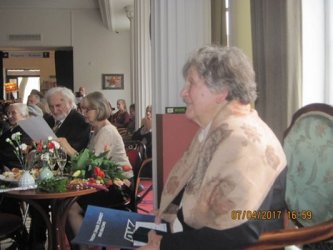
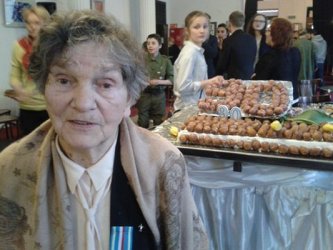
Wanda Traczyk-Stawska 90th birthday, right: birthday cake made of donats
Józef Piłsudski i Ignacy Jan Paderewski were honoured first.
Among the honoured individuals are statesmen, scientists, artists, to name some of them: Pope John Paul II, Dalai Lama, Maria Skłodowska-Curie, Stefan Starzyński, Lech Wałęsa, Lech Kaczyński, Andrzej Wajda.
Titles of the honorary citizen of the capital are traditionally given every year on the eve of the anniversary of the outbreak of the Warsaw Uprising. It is related to the fact that among over 70 honoured individuals, there are almost 20 Warsaw Insurgents: Erwin Axer, gen. Stefan Bałuk ps. :Starba", Władysław Bartoszewski, płk Janusz Brochwicz-Lewiński ps. "Gryf", prof. Wiesław Chrzanowski, Stanisław Jankowski "Agaton", Jan Nowak-Jeziorański ps. "Jan Zych", Franciszek Kamiński ps. "Olsza", prał. Wacław Karłowicz, prof. Witold Kieżun ps. "Wypad", Zofia Korbońska, Kazimierz Leski ps. "Bradl", Witold Pilecki ps. "Witold", Symcha Ratajzer-Rotem ps. "Kazik", bp Kazimierz Romaniuk, Irena Sendlerowa, Maria Stypułkowska-Chojecka ps. "Kama", gen. Zbigniew Ścibor-Rylski ps. "Motyl".
This year, on the eve of the 73rd anniversary of the outbreak of the Warsaw Uprising, during the solemn City Council session on the Memorial Day of Warsaw at the Royal Castle, Wanda Traczyk-Stawska ps. "Pączek" joined the ranks of the honorary citizens of Warsaw.
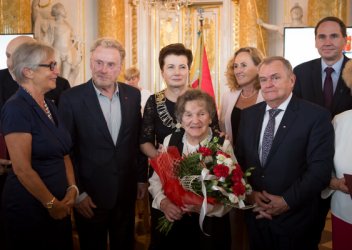
Mrs Wanda Traczyk-Stawska (in the middle), Mr Daniel Olbrychski (left),,Mr Wiesław Johann (right)
In the near future, the Warsaw Insurgents Cemetery and its surroundings await next developments. There were placed three plaques by the entrance of the "Keep them in our memory" exhibition. One of them reads "a future Memorial Wall will be a testimony of the Warsaw citizens' tragic fate in the year 1944". The Wall will be similar to the Memorial Wall of which is located in the Freedom Park situated in the Warsaw Uprising Museum.
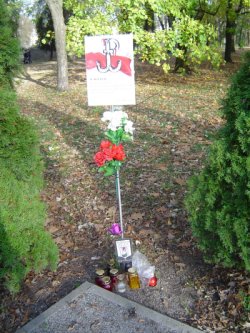
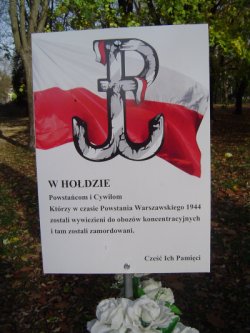
Next to the alley where the exhibition "Keep them in our memory" is presented, there is an information plaque commemorating insurgents and civilians
transported during the Uprising to the German death camps and were murdered there.
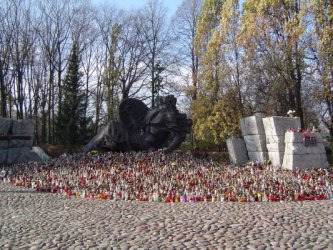
Mass grave of over 50 000 residents of Warsaw and insurgents, autumn 2017
Both brothers, soldiers-scouts of the battalion "Zośka" that belonged to the Home Army "Radosław" regiment, died in the Warsaw Uprising, fighting.
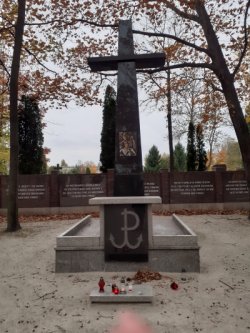
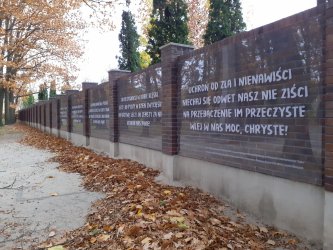
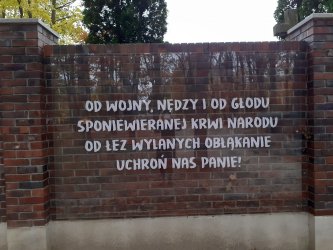
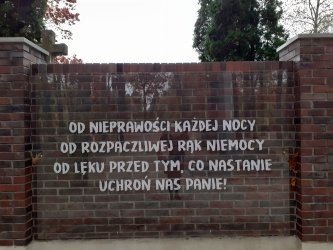
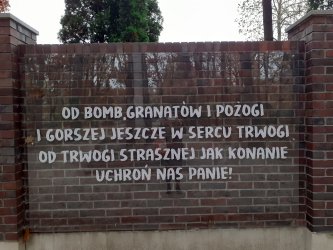
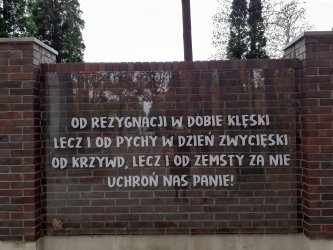
translated by Janusz Kocerba
As a result of the above-mentioned, on September 10, 2018 the Warsaw Management of the City Expansion signed a contract with Mr. Piotr Bujanowski, an architect and author of the victorious Project of the Memory Hall. It concerns working out the records of both project and action as well as author supervision of the investment task entitled "The Memory Hall beside the Cemetery of the Warsaw Insurgents in Wola district - preparatory work".
Having cancelled the first allocation by tender, the City of Warsaw made a decision to add the missing amount of money in the second allocation by tender. The Hall is said to cost 23,1 million of PLN and be ready in less than two years, until July 6, 2022.
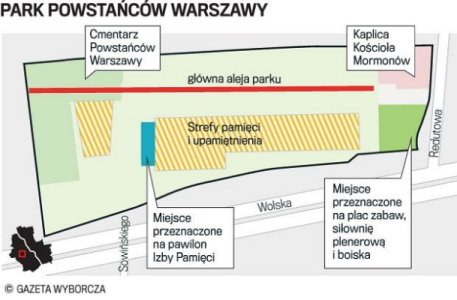
future placement of the Memory Hall according to Gazeta Wyborcza
The Hall is planned to be situated in the park section, far from the burial mound and the graves. Inside people will find exhibitions of the Cemetery's history the life in the occupied capital city and the ones dedicated to the German crimes in Warsaw.
Next to the Hall there will stand eight modules of the Memory Wall. On seven of them there will be put plates with information about the victims, whereas on the eighth module, situated nearby the entrance, one will find a piece of information about the whole idea and the theme of this commemoration.
Wanda Traczyk-Stawska a.k.a. "Pączek" - the chairman of the Committee for the Cemetery of the Warsaw Insurgents,
Tomasz Grodzki - the Speaker of the Senate of the Republic of Poland,
Małgorzata Kidawa-Błońska - the vice-marshal of the Sejm of the Republic of Poland,
Konstanty Radziwiłł - the Mazovia Voivode,
Rafał Trzaskowski - the President of Warsaw,
Ewa Malinowska-Grupińska - the chairman of the Council of Warsaw,
Kazimierz Nycz - Cardinal, the Metropolitan of Warsaw,
Józef Guzdek - General of Brigade, the Bishop of the Polish Army,
Krystyna Kmicikiewicz-Czechowska,
Hanna Kmicikiewicz-Pawlak,
the insurgents: Anna Przedpełska-Trzeciakowska a.k.a. "Grodzka", Tadeusz Jarosz a.k.a. "Topacz", Witold Cegieła a.k.a. "Tolek",
as well as Polish parliamentarians, mayors of Warsaw districts, members of the Council of Warsaw and inhabitants of Warsaw.
Mrs. Hanna Kmicikiewicz and Mrs. Krystyna Kmicikiewicz are the daughters of Major Włodzimierz Kmicikiewicz a.k.a. "Lech", the surgeon, who was murdered by Germans during the pacification of the field hospital in Wola district.
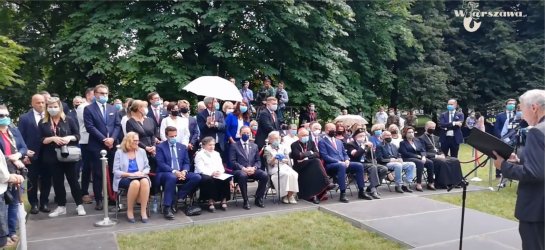
inauguration of the ceremony (photograph taken by Michał Pawlik)
pitting from the left: Ewa Malinowska-Grupińska, Rafał Trzaskowski, Wanda Traczyk-Stawska, Tomasz Grodzki, Anna Przedpełska-Trzeciakowska,
Kazimierz Nycz, Konstanty Radziwiłł, Tadeusz Jarosz, Witold Cegieła, Małgorzata Kidawa-Błońska, Józef Guzdek.
Warsaw districts' Mayors and Vice-President of Warsaw Mrs. Renata Kaznowska are standing at the back
Wanda Traczyk-Stawska said, among the others,
Human memory is the most important method of showing gratitude. The Cemetery will not speak of itself without the Memory Hall. Today is the day when my dream has been fulfilled. I ask you, Mr. President, and you, Mr. Voivode, may it be equipped on the City of Warsaw. We must be united, never again apart.
Here my friends lay in these graves, who belonged to different groups. Here Jews lay, and secular ones, and communists. When the moment came for the Uprising to outbreak, we were together and kept on fighting together for 63 days. May that tradition of being together last in Warsaw, may we take care together of this amazing city and this treasure, I mean this Cemetery.
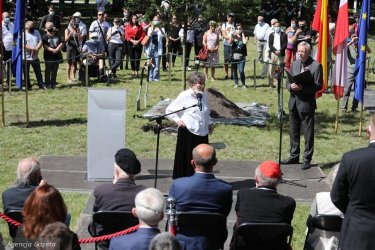
Mrs. Wanda Traczyk-Stawska is making a speech (photograph taken by Michał Pawlik))
In these days we remind ourselves of unbelievable inhumanity of German criminalists whose aim was to - literally speaking - murder this city on one hand, and on the other hand, we think a lot of immense proves of patriotism, bravery, solidarity and honour - the features that were presented by the insurgents and all inhabitants of Warsaw. For all of us the attitude of the insurgents is grand obligation, also individual one.
Shouldn't we nowadays, when there is no need to fight, focus on building bridges rather that barricades between ourselves? I believe it to be that obligation and that message which ought to be remembered from these days we are now living.
Rafał Trzaskowski said, among the others,
Imageries of those days never cease to leave us, regardless how old we are. The symbols that we have deeply in our DNA, have been sacred for us, they prove what the most important values for us are.
Today we start implementations of the new stage of keeping memory. The Memory Hall will rise here, with recordkeeping of the Massacre of Wola district and slaughter of civilians in Warsaw. This construction site is the result of efforts made by the whole Committee guided by Mrs. Wanda Traczyk-Stawska. May this special place rem ind everyone of devotion of Warsaw inhabitants.
May it also be a caution for the future that each war gives terrible consequences bot only for its heroes but for civilians, too. The latter must cope with the consequences for next dozens of years. Preserving memory and sharing it with our children, let's do absolutely everything not to allow any Polish generation experience the fate of inhabitants of Warsaw in the year 1944.
Ewa Malinowska-Grupińska said, among the others,
In our tradition a grave is very important. My grandfather was killed in the Warsaw Uprising. I am lucky as I know where his grave is and I can visit him there. Here one hundred thousand people are buried, whose names are not known by their families, despite immense work to find them. After the war 5,5 tones of ash were supplied to the cemetery.
Then the years came when for political purposes the truth was distorted, the one that is nowadays being unveiled. Lies, lies, lies for political reasons. And one fragile, short woman said - no. One fragile, short woman defeated all those liars.
After the speeches the charter of foundation of the Memory Hall was read out:
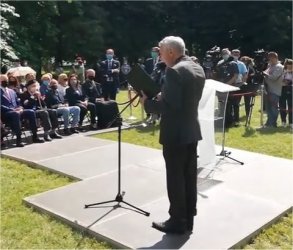
charter of foundation is being read out (photograph taken by Michał Pawlik)
To live in your own city, to live for your own city and to be buried among your dear ones - that is a Simple human wish.
For the generation that experienced the trauma of the Second World War it changed into unbelievable terror and tragedy.
Even people who well remembered the previous wars and their consequences, could not imagine, what kind of judgment can be passed on the city and its inhabitants.
Warsaw dwellers, common people, ordinary as we are, heroes of their everyday lives, not giving up hope for liberation and the uprising that would solve Warsaw, and for armed deed penalizing murders and executioners for the miracle of the end of the WW II.
They did not live to see the reward for surviving five years of inhuman occupation. They were murdered together with their city, sentenced to martyrdom, faceless death and nameless shared grave.
Here at the Cemetery of the Warsaw Insurgents, at the foot of the grave-mound with the ashes of our grandparents, parents, brothers, neighbours and our great Warsaw relatives.
We do know that hatred is able to have the last laugh over life but is unable to conquer memory and love.
Here, where both soldiers and civilians who heroically fought in the Warsaw Uprising lay together, we now prove our memory of extraordinary people of that invincible Warsaw.
Here we will arise the Memory Hall. Newborn Warsaw dwellers will be coming here in order to understand, remember, get to know, not forget. They will come to feel they are the relatives of those whose ashes found shelter in this soil.
This building will be only a quiet place of these bright good places which have been for dozens of years and forever opened for them in our hearts and our memory.
Inhabitants of Warsaw, relatives of those who had lived before us, caring for the memory for future generations:
Wanda Traczyk-Stawska - the chairman of the Committee for the Cemetery of the Warsaw Insurgents
Cardinal Kazimierz Nycz - the Metropolitan of Warsaw
Konstanty Radziwiłł - the Mazovia Voivode
Rafał Trzaskowski - the President of Warsaw
Ewa Malinowska- Grupińska - the chairman of the Council of Warsaw
The charter of foundation was probated with the above-mentioned persons' signatures. Accompanied by the representatives of local government and notable guests, among the others, the daughters of Major Włodzimierz Kmicikiewicz, i.e. Mrs. Krystyna Kmicikiewicz-Czechowska and Mrs. Hanna Kmicikiewicz-Pawlak the signatories placed the charter of foundation in the roots of the Memory Tree on August 1, 2020.
When the charter of foundation had been read out, a small oak called the Memory Tree, was ceremoniously planted in the place of the future Memory Hall.
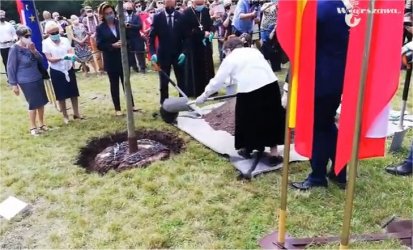
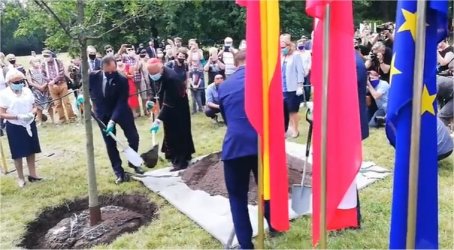
symbolic act of planting the Tree of Memory (photograph taken by Michał Pawlik)
The document was signed in the city hall by the President of Warsaw Rafał Trzaskowski and Mr. Michał Zydroń, the chairman of the company MTM Budownictwo from Tarnów.
If it was not for the efforts made by Mrs. Wanda, we would not be in this place today. I am very happy that we can keep our promise to build the Memory Hall by the Cemetery of the Warsaw Insurgents in Wola district.
Mrs. Wanda Traczyk-Stawska a.k.a. "Pączek" said,
Thank you very much for the fact I could live to see this moment. I must admit, it is very late because more and more of us are passing away, but I do expect I will be able to see the Memory Hall ready.
The whole speech of Mrs. Wanda can be read thanks to the kindness of Mr. Robert Hojda.
As mentioned above, the Memory Hall is to be risen till July 2022. The contractor is the consortium of companies MTM Budownictwo Sp. z o.o. and PBO Śląsk Sp. z o.o. The Implementation of the investment is supervised by the Warsaw Management of the City Expansion.
The authors of the project are the following persons: Piotr Bujnowski, Karina Jędrak, Maciej Koczocik, Krzysztof Makowski and Martyna Rowicka.
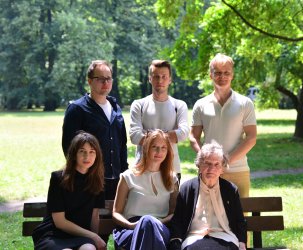
the team of designers (the source by Piotr Bujnowski)
architects sitting from the left: Martyna Rowicka, Karina Jędrak, accompanied by Mrs. Wanda Traczyk-Stawska,
architects standing from the left: Krzysztof Makowski, Maciej Koczocik, Piotr Bujnowski,
Before in the future we will enter the fully-prepared Memory Hall, let's experience the moment of thought while watching a film "12 ton. Oni tam wszyscy są".
The Memory Hall is said to be situated on the dedicated length of the Warsaw Insurgents park, along Józef Sowiński street starting from Wolska street in the direction of the cemetery wall.
The middle of February 2021 marked the beginning of the relevant building operations. The building site was surrounded with a high and sound fence on which a piece of information about the building details had been placed.
To change most of the ground from 1,5 to 5 meters deep turned out to be essential. It affected the date of beginning of laying the foundations
The building site was repeatedly inspected by Mrs. Wanda Traczyk-Stawska, who is known to be keenly interested in the building progress.
Let me remind you that on August 1, 2020 nearby the place of the above-mentioned ceremony a little oak called a Memory Tree was planted exactly on the place of the future Memory Hall. In the oak's roots the charter of foundation of the Memory Hall was put. Its title reads, "To live in one's family town...". You can read the content of this document thanks to the report of the Memory Tree planting.
Wanda Traczyk-Stawska a.k.a. "Pączek" - the honorary citizen of Warsaw, the chairman of the Social Committee for the Cemetery of the Warsaw Insurgents, the initiator and originator of the Memory Hall,
the insurgents and their families,
Małgorzata Gosiewska - the vice-marshal of the Sejm of the Republic of Poland,
Małgorzata Kidawa-Błońska - the vice-marshal of the Sejm of the Republic of Poland
Ryszard Terlecki - the vice-marshal of the Sejm of the Republic of Poland,
Rafał Trzaskowski - the President of Warsaw,
Ewa Malinowska-Grupińska - the chairman of the Council of Warsaw,
Kazimierz Nycz - Cardinal, the Metropolitan of Warsaw,
members of the Polish Parliament, aldermen, State officials, journalists and citizens of Warsaw.
Immediately before the solemnity Mrs. Wanda Traczyk-Stawska laid flowers by the monument called "the Mother" which had been unveiled in the year 2017 at the Social Committee's for the Cemetery of the Warsaw Insurgents suggestion as a tribute to numerous heroic mothers who had lost their children during the war. On the monument pedestal you can see a word MOTHER written in the following languages: Polish, Russian, German and Hebrew.
Mrs. Wanda Traczyk-Stawska at her passionate speech, raised a few essential issues.
"The main thing is, the city of Warsaw shall be the city of peace. This shattering cemetery where c. 104 thousand people are buried, shall call for peace worldwide...
The civilians were the most important part of the Uprising. Without the civilians the Uprising could not have lasted for 63 days. It must have been ended on the very first day. We were blond-stained, helpless, simply lost. The Warsaw civilians gave us bandages, food, a chance to take a rest...
Here at the cemetery you can find a marvelous poem written by a 17-year-old boy Jan Romocki a.k.a. "Bonawentury", brother of Andrzej Romocki a.k.a. "Morro". Its title is "Modlitwa Szarych Szeregów" ("Prayer of the Grey Regiments"):
...Od rezygnacji w dobie klęski,
Lecz i od pychy w dzień zwycięski,
Od krzywd - lecz i od zemsty za nie
Uchroń nas, Panie
Uchroń od zła i nienawiści.
Niechaj się odwet nasz nie ziści.
Na przebaczenie im przeczyste
Wlej w nas moc, Chryste
War is something terrific but one needs to forgive when it is over. People need to forgive one another because there must be peace in the world. We need peace in order to be able to live and be tolerant to each other...
We need to teach our children as they are most important. Future of the nation depends on upbringing of the young generation. No school should be dependent on a political party. It is wrong when people who teach children have their own views and want to implement them onto young people. School ought to be objective. School ought to love its pupils and respect them. No matter if a child is just one year old or only few months old - they have their human dignity. They start to think. And these thoughts ought to be free. Everyone has a right to think in a way their heart feels...
Everyone ought to remember of the Constitution. Everyone ought to know their rights and duties. The whole Poland ought to know that in order to save its human dignity. And to fight for it because fighting for human dignity means fighting for freedom and the right of each citizen to vote. Each person living in this country is independent and each vote has the same meaning as that of the marshal or the President. Even if it is the homeless', as it may happen...
The army ought to be objective, as well. No soldier has a right to be dependent on a political party. There is no place for any party in the army. Parties change every 5 years and each tries to push forward its viewpoints to soldiers who ought to be soldiers and citizens acquainted with the Constitution which is a crucial thing..."
Mrs. Wanda Traczyk-Stawska thanked both the former and the present President of Warsaw, i.e. Mrs. Hanna Gronkiewicz-Walz and Mr. Rafał Trzaskowski for their help in the execution of the project of the Memory Hall.
The whole speech of Mrs. Wanda can be heard through YouTube 1 thanks to the kindness of Mr. Michał Pawlik, editor-in-chief of Warszawa.pl .
Afterwards, President of Warsaw Mr. Rafał Trzaskowski took the floor..
"Every year we meet on the route that is followed to keep in memory the Warsaw Uprising. Some of us have been doing it for 77 years, others for a shorter time. And also in the Wola district, we are here every year...
Dear Sirs, last year we planted the Memory Tree and we listened to the charter of foundation. Presently, the building of the Memory Hall is slowly arising. And we can see that the works are being continued, which makes me happy...
Today we will be building in the corner-stone of the future institution which is very important for all of us. In the following days we will be honouring our late insurgents
But today at this place we tend to think especially of the civilians. We think of those mothers, fathers, grandparents, those who stayed at home when their children left to the Uprising. They must have been extremely alarmed, especially those who had lost their closed ones. My mother's brother died out twenty minutes before the Uprising as he served in the security staff company. It turned out to be one of the first battles of the Warsaw Uprising. Trauma remained for his sisters and parents for the rest of their lives. Such trauma stayed in those Warsaw families' DNA. We remember of suffering of those families which had to cope with pain since that time. Those wounds and that burden had to be carried over the years...
Most of the victims that lie here are nameless and this fact is very sad. That is why we want this place to be symbolic. The Memory Hall is to play such a symbolic role...
Last but not least, I wish to say a big thank you especially to Mrs. Wanda, for her being so firm, for being our conscience and her always urging us on."
The whole speech can be heard through YouTube 2 thanks to the kindness of Mr. Michał Pawlik, editor-in-chief of Warszawa.pl .
Next speech was given by the chairman of the Council of Warsaw Mrs. Ewa Malinowska-Grupińska.
"All the actions connected with the Warsaw Uprising tend to be immediately combined with the Museum of the Warsaw Uprising that is very dear to me. Yet, the Memory Hall will be the part of the Museum of the City of Warsaw. The employees of the Museum are very devoted to this work...
Mrs. Wanda is like the person who brings fire during the Olympic Games. And all the teams follow her. If there wasn't such a fire and such enormous energy, there wouldn't be all that. There are not enough words of gratitude for you, Mrs. Wanda...
Today's solemnity is a starting point of the whole schedule of celebrations whose aim is to honour the insurgents and the Warsaw Uprising itself...
Insurgents keep saying what you have just told us and what I had heard about in my family home. One of my grandparents got killed during the Uprising. My family members kept reminding that. Solely the one who had experienced five years of German occupation, time of bastardization and fear, has a right to evaluate. The one who hadn't lived then, has no right to estimate...
In the upcoming days we will be honouring those who had perished and those who had survived and we owe the Warsaw which we have to them. The meristem of the city was destroyed but I dare to say the Warsaw spirit lives on."
The whole speech can be heard through YouTube 3 thanks to the kindness of Mr. Michał Pawlik, editor-in-chief of Warszawa.pl
.
The speeches were followed by the act of building in the corner-stone of the Memory Hall. It was our duty imposed on us by our concern for the memory of the future generations to prepare the Memory Tuba. It was inserted into a symbolic fragment of the Memory Hall's foundation. Special commemorative brick trowels had been prepared, as well.
It was our duty imposed on us by our concern for the memory of the future generations to prepare the Memory Tuba. It was inserted into a symbolic fragment of the Warsaw Insurgents' Cemetery Memory Hall's foundation.
It contains: the photographs of the area taken before the construction had began, the photographs of the subsequent stages of building the Memory Hall,
the photographs of the solemnity of planting the Memory Tree of the insurgents, the civilians and the inhabitants of Warsaw perished in the Warsaw Uprising,
the photographs of the first pages of Polish daily papers dated July 29, 2021,
the biography of major Włodzimierz Kmicikiewicz compiled by his grandson,
the armband belonging to Mrs. Wanda Traczyk-Stawska, liaison officer a.k.a. Pączek, the armband belonging to Mrs. Halina Kieroń, insurgent nurse a.k.a. Irka,
the book written by Mr. Maciej Janaszek-Seydlitz entitled "The history of the forgotten cemetery",
he current coins as well as the directory of the celebrations commemorating the 77th anniversary of the Warsaw Uprising outbreak - all in electronic version.
Warsaw, July 29, 2021
Thereafter, Doctor Major Włodzimierz Kmicikiewicz was reminded in the following words,
During the German occupation he worked in Warsaw as a doctor in the Holy Ghost hospital. He was also a volunteer of the First Surgical Ward. Moreover, he worked as a doctor in the out-patients' clinic. He did private medical practice, as well.
In the Home Army he initially served as a Captain in the Home Army Headquarters Sanitation. He was a doctor of General Stefan Grot Rowecki, and of Tadeusz Bór Komorowski. Then he was promoted to the rank of Major.
He was shot to death as a supposed commander of a "bandit" hospital during the pacification of the insurgent hospitals in the Wola district. According to several witnesses, it occurred on so-called "Black Saturday", i.e. August 5, 1944, whereas others reported it as August 6, 1944."
Afterwards, the content of the charter of the Memory Hall foundation entitled "To live in your own city..." dated August 1, 2020, was read out.
The ceremony of building in the corner-stone followed. Seven above-mentioned guests actively participated in this stage of the solemnity.
They would symbolically, by turns, close the Memory Tuba in the concrete brick.
The act of building in the corner-stone can be watched in a YouTube 4 thanks to the kindness of Mr. Michał Pawlik, editor-in-chief of Warszawa.pl .
.
At the time of the above-described solemnity - construction works by the Memory Hall, just behind the enclosure, were in progress. The schedule is tight, indeed.
They were being continued regardless the weather conditions.
The construction crew members were conscious of the fact that the date of the Memory Hall opening had been established for the beginning of October 2022.
Mrs. Wanda Traczyk-Stawska was inspecting the Memory Hall construction site time after time.
photographs taken by: Agnieszka Pawelec
In the meantime the aim of full revitalization of the Cemetery of the Warsaw Insurgents was being realized step by step.
At the cemetery wall, where a poem "Modlitwa Szarych Szeregów" ("Prayer of the Grey Regiments") written by Jan Romocki a.k.a. "Bonawentura" had been placed before, its translations were also placed on both sides: the German and the Hebrew ones.
In July 2022, nearby the burial mound with the ashes of 50 thousand murdered and burnt inhabitants of Warsaw, at the suggestion of the Mazovian provincial governor Mr. Konstanty Radziwiłł, the legal caretaker of the Cemetery of the Warsaw Insurgents in Wola district, a cross was put. In the same place in the year 1945 by the common grave with human ashes there used to stand a simple metal cross. After the reconstruction of the grave and creating in the year 1973 the burial mound with the monument "Polegli Niepokonani" ("Fallen Invincible") the cross was removed.
An almost six-meter-high cross, designed by a sculptor Marek Moderau, who had also designed the granitic monuments by the entrance to the Cemetery from Wolska street, is believed to make people realize the huge number of the inhabitants of Warsaw who lie there. Its form, proportion and material are similar to the cross in Górczewska 32 street, that stands on the place of mass murder and burning the corpses of the Wola district's inhabitants.
On the big cross c. four thousand small "individual crosses" were placed as this is approximately the number of the identified victims who lie at the Cemetery.
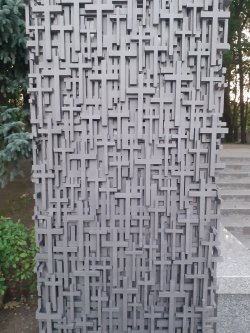
photographs taken by: Agnieszka Pawelec
The chairman of the Committee for the Cemetery of the Warsaw Insurgents, Mrs. Wanda Traczyk-Stawska made a summary of the revitalization works that had been finished until then. In her opinion, the cross ought to be placed on the burial mound with the ashes of more than 50 thousand people: soldiers, civilians, infants and old men, in accordance with Prof. Gustaw Zemła's project. She officially addressed the provincial governor at the Cemetery of the Warsaw Insurgents during the commemoration of the 78th anniversary of the Warsaw Uprising. The Mazovian governor ensured that another cross, appealed for by Mrs. Wanda Traczyk-Stawska, would be placed on the common grave.
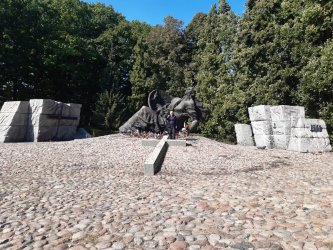
a mock-up of the cross on the burial mound
The date of the Memory Hall opening was closer and closer. Works inside the exhibition rooms began, followed by tidying up the surrounding area, planting grass and ornamental bushes, etc.
Inside the exhibition rooms electrical and electronic supplies were being installed whereas the displays - prepared.
photographs taken by: Agnieszka Pawelec
photographs taken by: Agnieszka Pawelec
Just before the whole project was finalized, the enclosure had been removed.
On October 2, 2022, on the day of both the 1944 Uprising decline anniversary and the Day of Remembrance of the Civil Inhabitants of the Insurgent Warsaw, the Memory Hall beside the Cemetery of the Warsaw Insurgents in Wola district, the new department of the Museum of Warsaw, was officially opened.
In the solemnity the following people gathered,
Mrs. Wanda Traczyk-Stawska a.k.a. "Pączek" - the chairman of the Social Committee for the Cemetery of the Warsaw Insurgents,
Mr. Rafał Trzaskowski - the President of Warsaw,
Mrs. Ewa Malinowska-Grupińska - the chairman of the Council of Warsaw,
together with Mrs. Małgorzata Kidawa-Błońska - the vice-marshal of the Sejm of the Republic of Poland, the ambassador of Germany Mr. Thomas Bagger, family members of the people buried at tha Cemetery, the Warsaw Insurgents, members of the Polish Parliament, and the Polish State officials.
|
first on the right side: Ambassador of Germany Mr. Thomas Bagger |
photographs taken by: Ewelina Lach
First, the guests were shown round by Mrs. Karolina Ziębińska-Lewandowska, the Manager of the Museum of Warsaw.
photographs taken by: Ewelina Lach
At 12:00 sharp the solemnity of the Memory Hall opening began.
The act of official opening was made by Mrs. Wanda Traczyk-Stawska, the chairman of the Social Committee for the Cemetery of the Warsaw Insurgents, Mr. Rafał Trzaskowski, the President of Warsaw and Mrs. Karolina Ziębińska-Lewandowska, the Manager of the Museum of Warsaw.
During the ceremony these people took the floor consecutively: Mrs. Wanda Traczyk-Stawska, Mr. Rafał Trzaskowski and Mrs. Ewa Malinowska-Grupińska and Mrs. Karolina Ziębińska-Lewandowska.
Wanda Traczyk-Stawska said inter alia,
photographs taken by: Ewelina Lach
"(...) The families of those who are buried here are dearest for me. 104 thousand 105 people lie here and this Cemetery is their voice. This Memory Hall is to call loud to the whole world: No more wars
.
No more. But the war in the Ukraine is in progress these days. And that is why we all human beings must call loud: No more wars. We mustn't let any war be continued...
Just have a look, such beautiful is the world. This world is going to be destroyed by these wars. We mustn't let the weakest civilians be murdered. Soldiers have weapons whereas civilians have nothing but a voice. Women's duty is to care for their children, not allow them die."
The President of Warsaw, Rafał Trzaskowski said inter alia,
photographs taken by: Ewelina Lach
"Today we think of all the people who are buried here. This is a special moment, a moment of strong emotion, a peculiar moment, indeed. We all remember about what was happening in those days.
The Memory Hall is a proof of the sacrifice of our city... When you enter the Memory Hall, you see the map of Warsaw which indicates with red pins the places where the Warsaw inhabitants were murdered. This red area is huge. The most tremendous is the area here, in Wola district.
The Memory Hall's aim is to serve everybody, to allow us listen to the voice of the ones who survived and tell us about what had been happening here in Wola district and about more that 100 thousand people who were buried here. Undoubtedly, that memory must survive.
Such places should scream. Such places, not politicians. This is what real patriotism is about: we should listen to the heroes' voice. We must remember, we must appraise the the causers on what had been done but also we must look forward, into the future. Nobody should exploit the notion of history. No political struggle should make use of history.
The Memory Hall is to be a place of reflection on the consequences of violence, war conflicts and being radical. Many victims buried here, in the burial mound and common graves, are nameless. We want this place to be symbolic. To remember about annihilation of the civilians is our common duty."
The chairman of the Council of Warsaw, Ewa Malinowska-Grupińska, said inter alia,
photographs taken by: Ewelina Lach
"What we can hear here today is a set of very important words: peace, war, also brotherhood. Friendship was a crucial thing for the Insurgents. These places call loud how needed is friendship, support, brotherhood, co-operation, being together. Mrs. Wanda, you are indeed a person who makes us better people."
The Manager of the Museum of Warsaw, Karolina Ziębińska-Lewandowska, said inter alia,
photographs taken by: Ewelina Lach
"We are making efforts to fill in a gap of memory about the victims whose fate and names had been forgotten. We want the Memory Hall to become not only the place of saving the victims of the Warsaw Uprising from being forgotten but also the place of debates over various conflicts and the ability of holding dialogues, as well as the place of commemoration and living memory.
Here adults, children and young people will have a chance to develop their abilities of respekt towards others, tolerance, understanding and living in communities."
The complex of the Memory Hall is situated on the area of the biggest war cemetery in Poland - the Cemetery of the Warsaw Insurgents. It consists of two exhibition halls made of strict concrete, linked with the Memory Wall. The whole building gives an impression of a grim bunker. This effect is purposeful as while leasing it one can see the beautiful world around.
Above the exhibition rooms there are kind of roofs giving an impression of hanging in the air. Between the exhibition rooms, in turn, one can find a yard where the Memory Wall plaques are placed.
photographs taken by: Ewa Bratosiewicz
In the first exhibition room, the one from the direction of Wolska street, visitors can enter a bookstore and a reception hall whereas the exact Memory Hall is to be found in the second exhibition room.
While walking through the passage in the first exhibition room, on the right-hand wall one can see the following texts on brass plaques,
the quote of Olga Tokarczuk, the Nobel Prize winner:
"Coś, co się wydarza, a nie zostaje opowiedziane, przestaje istnieć i umiera",
("What happens and is not recounted afterwards, ceases to exist and dies out"),
photographs taken by: Ewa Bratosiewicz
Next to the above-mentioned, one can see another inscription in two languages: Polish and English,
photographs taken by: Ewa Bratosiewicz
"Hall of remmembrace at the Warsaw Insurgents Cemetery In Wola. In memory of thousands of people murdered and killed In the freedom uprising in 1944, burried in his cemetery and elsewere. In memory of the war victims, named and unnameded alike.
The community of Warsaw."
photographs taken by: Ewa Bratosiewicz
On the other side of the wall an amazing brass emblem of Warsaw was situated. The archer of the Fighting Poland is to be seen on the stanchion nearby.
In the main building of the Memory Hall there is a double area: the Room of History and the Room of Testimonies.
The Room of History has a main aim which is to present the fate of the Cemetery of the Warsaw Insurgents and the complicated ways of its commemorating throughout the last decades. It fits the education path of children, Young people and adults alike.
The exhibition show the post-war action in favour of building the Cemetery of the Warsaw Insurgents.
The story begins with the photographs taken immediately after the Warsaw Uprising. They show the capital city of Poland and how it was destroyed - the city was turned into ruins. Graves among the ruins are visible.
photographs taken by: Ewelina Lach
Visitors can get to know the history of struggling for proper commemoration of the victims of the 1944 Uprising. There are four sections,
- exhumations (1945-1947),
- the Cemetery of the Fallen in the Uprising (November 1945-the early 1950s, i.e. till burying the victims were being made),
- blanking out the memory of the Warsaw Uprising (1950s-1980s),
- retrieving from being forgotten (1990s-2022).
Each section is completed with scans of the photographs, documents, newspapers fragments found in the Museum of Warsaw's collections and inquiries.
The content is available in both languages: Polish and English.
One of the most important elements of this part of the exhibition is a scan of the Book of the Buried in the Cemetery. The Book included the admissions made from November 30, 1945 till the year 1957 and single ones from later time. The last admission is dated June 21, 2001. More than 320 sheets of the Book have an abbreviation "N.N." (unknown) in the box name and surname, which makes them ones of the most shocking evidence of the tragedy of the Uprising.
The exhibition's last element is a film with the message by Mrs. Wanda Traczyk-Stawska, the initiator and originator of the Memory Hall, uttered for the next generations.
photographs taken by: Ewa Bratosiewicz
with a map of the left-bank Warsaw, the bird's eye imagery, which indicates with red pins the places where the Warsaw inhabitants were executed and both civilians and insurgent were temporarily buried. In Wola district there are so many red pins that one can see a huge red spot. The Old Town looks alike on the map.
|
Wola district |
Old Town district |
photographs taken by: Ewa Bratosiewicz
In the Room of Testimonies visitors will be able to see in the future multimedia exhibition by Krzysztof Wodiczko, a worldwide known visual arts author, aesthetician and lecturer of the Harvard Graduate School of Design.
The Memory Wall is also a part of the Memory Hall. It is believed to be the epitaph for All the victims of the Warsaw Uprising. The Memory Wall is situated outside, on both sides of the building. It has got seven constituents, five of which are from the direction of Wolska street and two from the direction of the monument Fallen Invincible.
photographs taken by: Ewelina Lach
Each part consists of double-sided plaques. There are fourteen huge walls overall on which there are small plaques with the names of the victims of the Warsaw Uprising.
On the Memory Wall one can find 93 thousand and 240 brass plaques with the names of 62 thousand identified persons. One third of all the plaques is empty. There is place for other names to be written progressively.
|
|
The aim of the Memory Hall is to pin down as many named victims as possible. Each year, on October 2, subsequent names are to be added on the empty plaques. An e-mail murpamieci@muzeumwarszawy.pl will be available.
The existing list of names is based on the data gathered until now by the Museum of the Warsaw Uprising and as a result of activity of the Social Committee for the Cemetery of the Warsaw Insurgents.
The person responsible for construction of the Memory Hall is Mrs. Aleksandra Sułtan-Lipska, The manager of the Memory Hall is Mr. Michał Wójcik, journalist and historian.
Visitors can enter the Memory Hall from three directions: the Cemetery, the Park and Wolska street, where the smaller exhibition room with a bookstore, a café and information desk is situated.
The Memory Hall was opened for visitors on October 4, 2022..
A drawback for large groups and tours is inability to park coaches nearby the Memory Hall. The solution may be to use a car park in Redutowa street, about 400 meters away from the Memory Hall. Is seems to be a good place for tour participants to leave a bus.
Individual guests, however, have a wide range of public transport (a few tram lines and a tram stop directly by the Memory Hall).
October 2022
*
It was October 2022 when the Memory Hall beside the Cemetery of the Warsaw Insurgents was officially opened. In the Room of Testimonies a temporary exhibition was installed, the one that indicates the places where the Warsaw inhabitants were executed and temporarily buried. In the same Room the multimedia exhibition created by Krzysztof Wodiczko was announced to be opened the following year. And it was, indeed.
The appointment was kept: on October 2, 2023, the Day of Remembrance of the Civil Inhabitants of the Insurgent Warsaw, the exhibition entitled "Voices of Memory" was officially opened.
The following people participated in this solemnity: the President of Warsaw Mr. Rafał Trzaskowski, the chairman of the Social Committee for the Cemetery of the Warsaw Insurgents Mrs. Wanda Traczyk-Stawska, the ambassador of the Federal Republic of Germany Mr. Viktor Elbling, the author of the exhibition Mr. Krzysztof Wodiczko, the Manager of the Museum of Warsaw Mrs. Karolina Ziębińska-Lewandowska, as well as the people whose memories had been used in the exhibition, and other guests.
Here are the ones who took the floor consecutively during the ceremony: Mrs. Wanda Traczyk-Stawska, Mr. Rafał Trzaskowski, Mr. Viktor Elbling, Mrs. Karolina Ziębińska-Lewandowska, and Mr. Krzysztof Wodiczko.
Mrs. Wanda Traczyk-Stawska a.k.a. "Pączek", the initiator of the Memory Hall, first expressed her thanks to Mr. Krzysztof Wodiczko for an outstanding idea he successfully presented in the "Voices of Memory" exhibition.
She said inter alia,
photograph taken by: Rafał Motyl
"(...) Neither of the occupied countries has such a history as Warsaw does. What an amazing way you were able to show that (...) Its modern form's aim is to show the history that is to be found here, at this cemetery, and calls: never again! May no more casualties among innocent human beings, i.e. children, elderly people and weaponless adults (...) Long live Warsaw, may it flourish, may it call upon the whole world to live in peace. Cause there is no other such a city that rose from the dead."
Mr. Rafał Trzaskowski said inter alia,
photograph taken by: Rafał Motyl
"(...) October 2 is known to be the Day of Remembrance of the Civil Inhabitants of the Insurgent Warsaw. (...) The last day of the Warsaw Uprising is not a date chosen by accident. Then the civilians were forced to leave the city ruins. (...) Thousands murdered people were left here, often buried in unnamed graves. This is the reason why that day is so important for us. Mrs. Wanda is the one who did most to remind us of the civilians' sacrifice. Among the main heroes of the Warsaw Uprising were civilians, indeed, (...) This place is unique. This exhibition is unique, as well, because it reminds us of the history in a way that is both modern and touching. (...) The thing is, we ought to learn from the history. We must not forget about what had happened. We have to remember who was to blame, we must not fake the history. Conversely, we have to speak about our history loud worldwide. It is also essential to draw conclusions. ( ...) Today i salso time to think what a reply to a war tragedy is. The right answer is the European integration. It was planned in such a way not to allow a war in Europe happen again."
The ambassador of the Federal Republic of Germany Mr. Viktor Elbling also rose to speak.
photograph taken by: Rafał Motyl
He stated that Germans remember the tragedy that the Warsaw civilians experienced several decades ago. The process of reconciliation of the nations of Poland and Germany has to be continued.
He reminded us of the fact that the project "Voices of Memory" is co-financed by the Ministry of Foreign Affairs of the Federal Republic of Germany.
The Manager of the Museum of Warsaw Mrs. Karolina Ziębińska-Lewandowska emphasized the uniqueness of the Memory Hall building designed by Mr. Piotr Bujnowski.
She said inter alia,
photograph taken by: Rafał Motyl
"(...) It is the first in Warsaw building-monument that commemorates the civilian casualties of the Warsaw Uprising. (...) While entering it, we are not supposed to 'scratch our wounds', or to revel in the past and despair. We are likely to have a moment of reflection, a thought what the past taught us. What had had to happen that the civilians were murdered due to hatred and dehumanization. I wish this place taught us the sane patriotism. I wish it was important for us. I wish the stores were told in a modern language and used a metaphor that leaves space for us to find ourselves".
Mr. Krzysztof Wodiczko gave a speech, as well,
photograph taken by: Rafał Motyl
""Voices of Memory" is an audiovisual space full of the words of both direct witnesses of the Warsaw Uprising, and indirect witnesses who remember what they once heard from their parents or grandparents. I can call it an attempt to search proper words to say what is impossible to express by means of words. (...) The several stories make up the whole and last for about one hour - this is how much it takes you to listen to everybody. You can also come and start listening in a moment of your choice. (...) I particularly admire and feel grateful to Mrs. Wanda Traczyk-Stawska for her moral leadership and priceless testimony included in "Voices of Memory"."
The exhibition author Mr. Krzysztof Wodiczko is one of best-known contemporary visual artists. Born in Warsaw, he is a lecturer at the Warsaw Academy of Fine Arts, the Massachusetts Institute of Technology and the Harvard Graduate School of Design in Boston, a worldwide known visual arts and theory texts author.
It is worth mentioning that the exhibition "Voices of Memory" has become the central part of the Memory Hall. The interior of the exhibition hall is now filled with the testimonies of those who witnessed the German crimes, as well as the witnesses' close ones. The war experience is recalled by civilians, soldiers and then youngsters who have never ceased to bear the seal of suffering.
photograph taken by: Rafał Motyl
"Voices of Memory" reveal a tragic fate of civilians who lived in Warsaw during the Warsaw Uprising in the year 1944. The exhibition is generally believed to be a touching record of the sacrifice of the inhabitants of Warsaw, displaced and murdered in numerous mass executions.
Each voice heard in a dark room-sarcophagus is accompanied by a candle flame that visualizes the sound.
photograph taken by: Rafał Motyl
The testimonies may be listened to from inside the exhibition space. Visitors may, for a change, walk and stop in front of a particular video scene, i.e. flames that move together with the spoken words. The whole audiovisual exhibition is repeated in cycles, one of which lasts for about an hour but, as it was previously mentioned, one can also come and start listening in a moment of one's choice.
Forty witnesses' stories compose the exhibition. Here are the witnesses:
Bohdan Bartnikowski, Helena Bułgarska, Elżbieta Gutowska-Niedziałek, Tomasz Karasiński, Wiesław Kępiński, Elżbieta Leszczyńska, Monika Lurie, Stanisław Maliszewski, Stefan Niesłuchowski, Tadeusz Rolke, Łucjan Sokołowski, Jadwiga Szczęścik-Parucka, Krzysztof Szlifirski, Wanda Traczyk-Stawska.
And here is the transcription of the memories used in "Voices of Memory":(transcription).
The exhibition "Voices of Memory", created in co-operation with the Foundation Profile and the Embassy of Germany, was funded by the capital city of Warsaw and the Ministry of Foreign Affairs of the Federal Republic of Germany. The project has been under the honorary auspices of the President of Warsaw.
The act of equipping the Memory Hall with this heartbreaking exhibition is said to symbolically finish the process of regaining the Cemetery of the Warsaw Insurgent out of the state of oblivion. Thanks to persistence and perseverance of a few people, Mrs. Wanda Traczyk-Stawska above all, as well as kindness shown by the authorities of the capital city of Warsaw, this once forgotten cemetery became known for inhabitants of Warsaw and travellers, being a witness of a tragic fate and sacrifice of the civilians during the Warsaw Uprising (August-October 1944)..
The main message of the place to which we have devoted ourselves while preparing and translating this several-part article is: never again! A war that costs lives of so many innocent human beings, adult, young and elderly, should never happen again. One should always look for friends, not enemies.
November 2023
compiled by Maciej Janaszek-Seydlitz
translated by Monika Ałasa
Copyright © 2021-2023 SPPW 1944. All rights reserved.